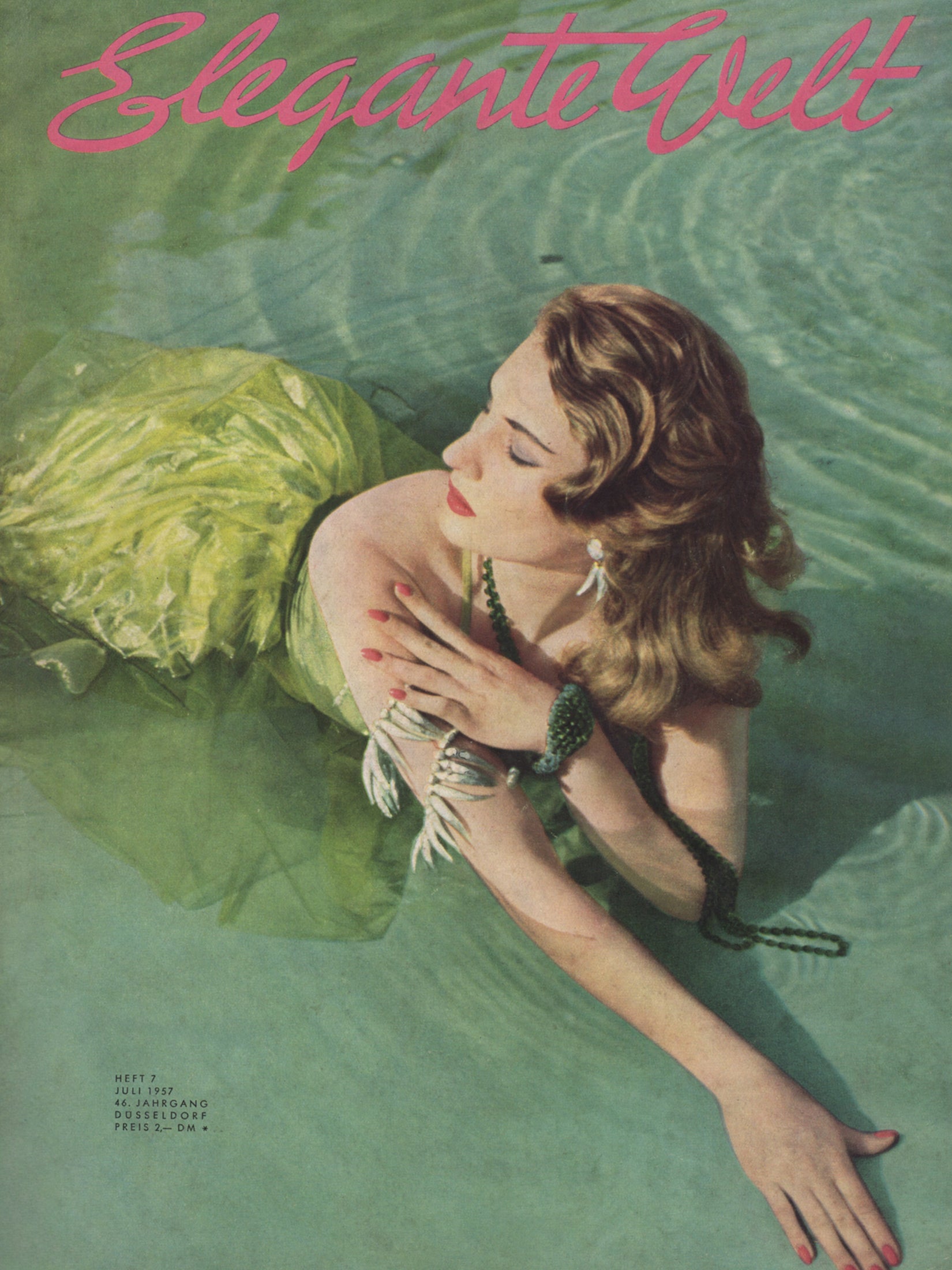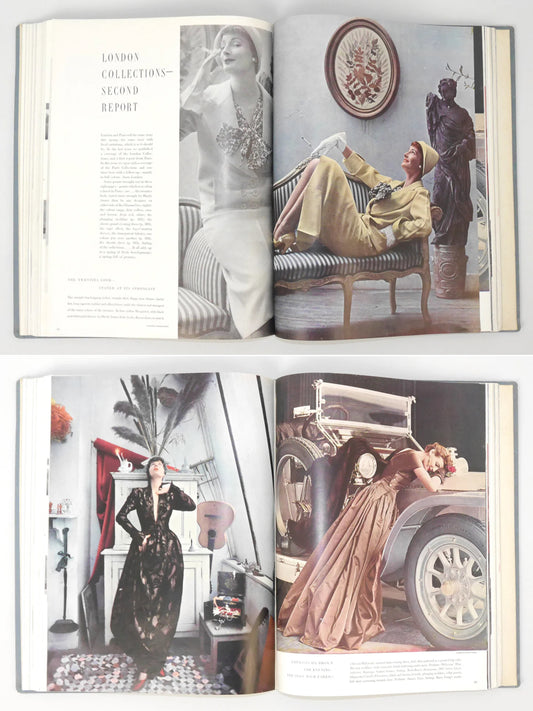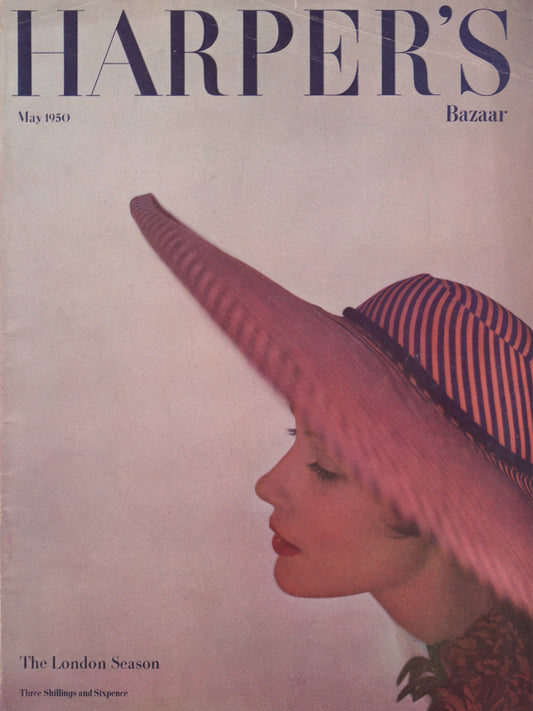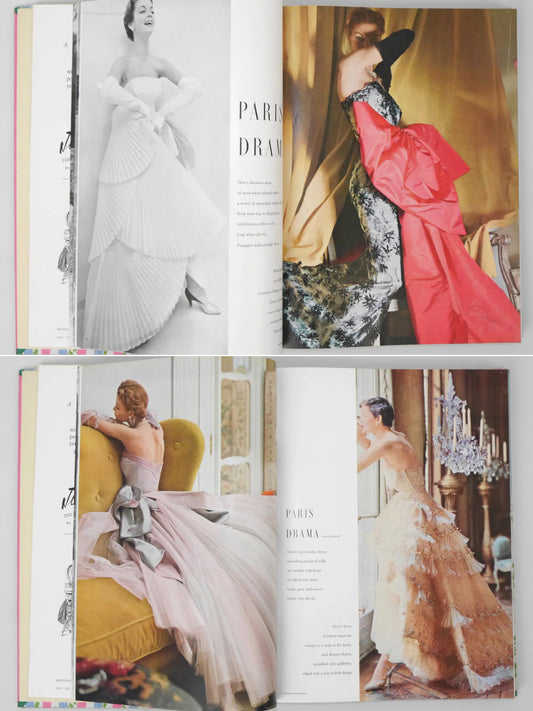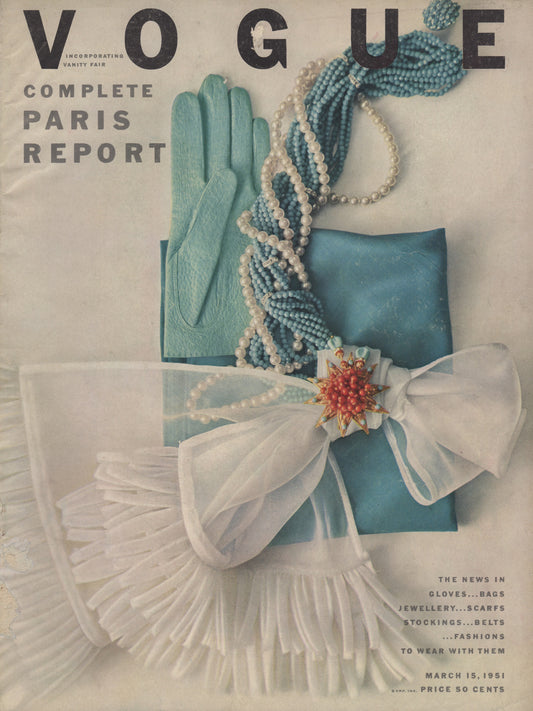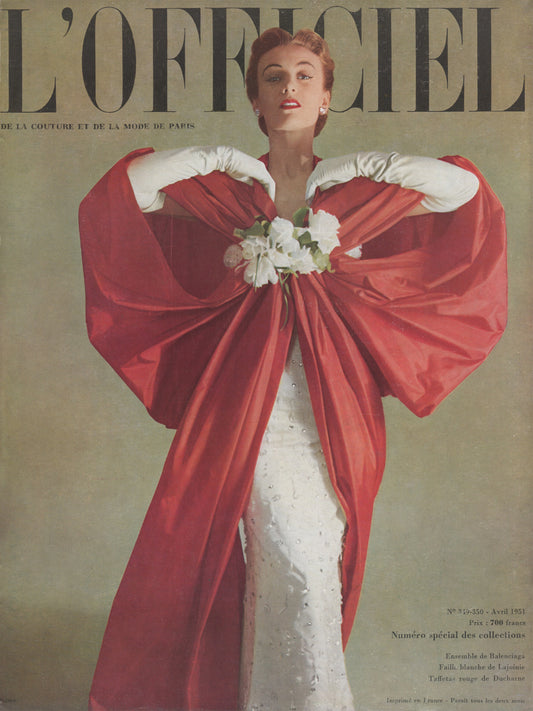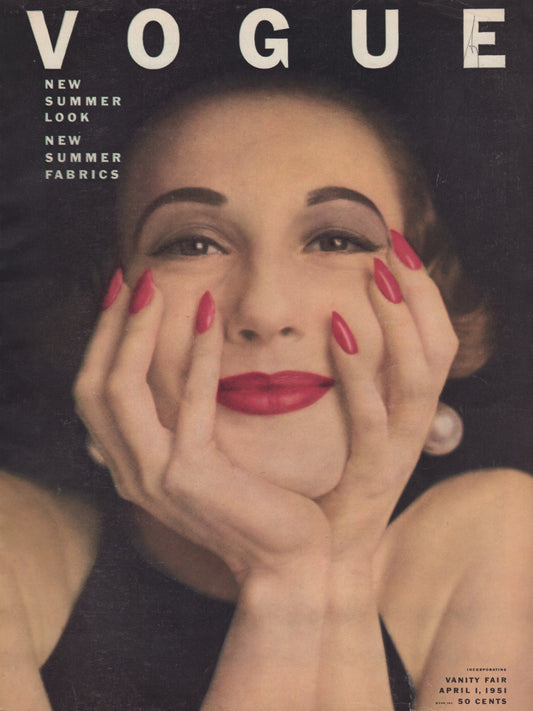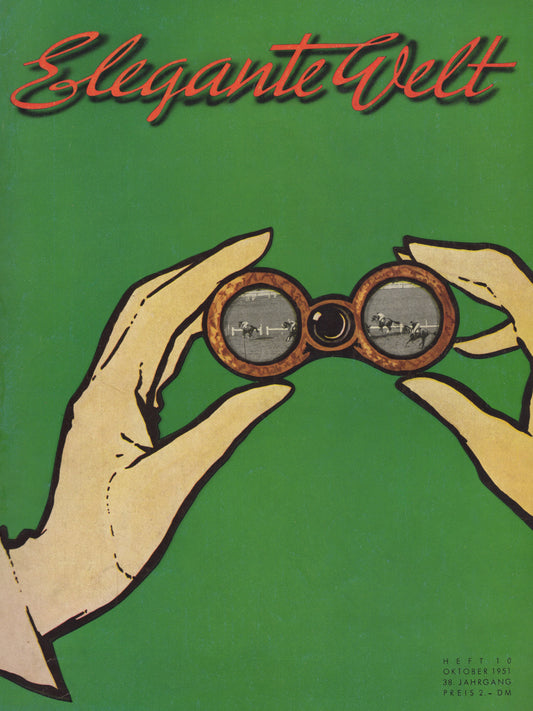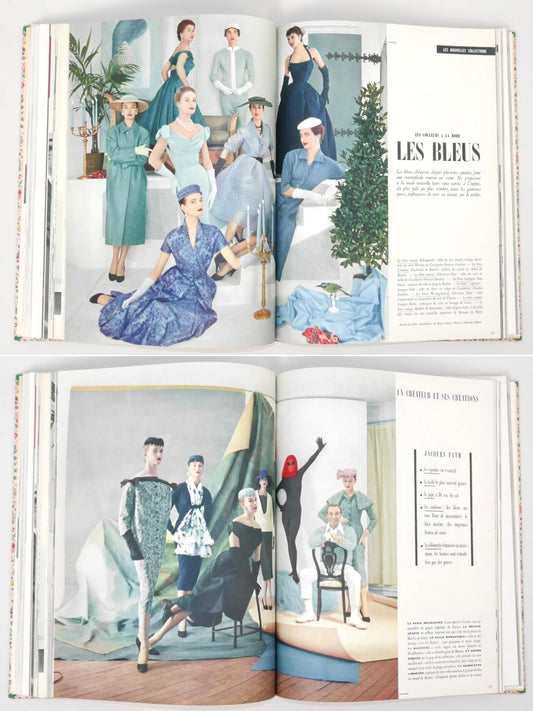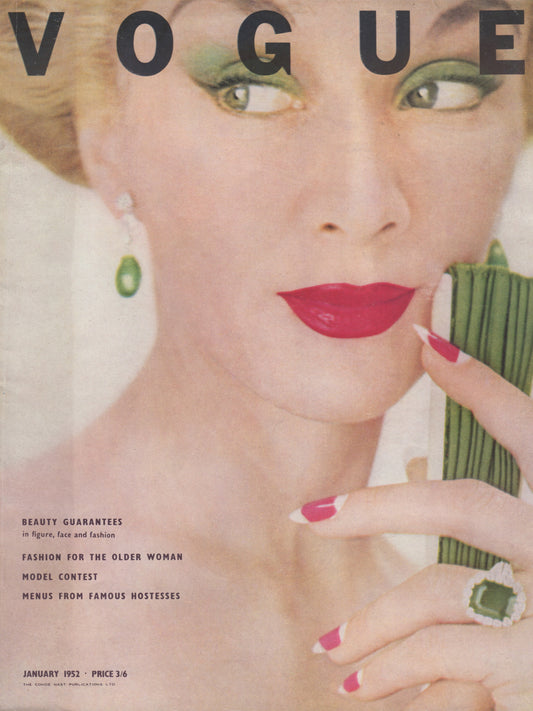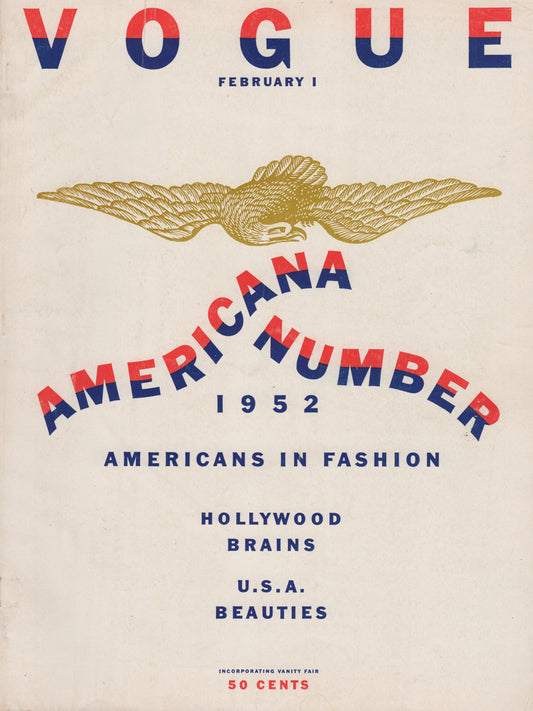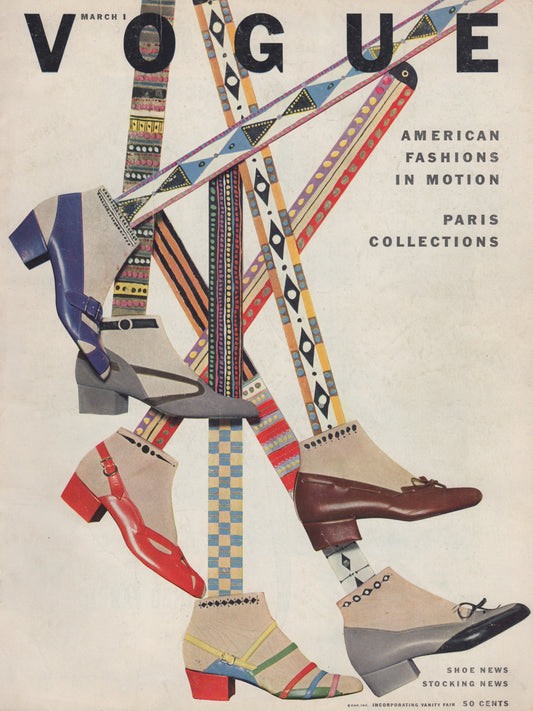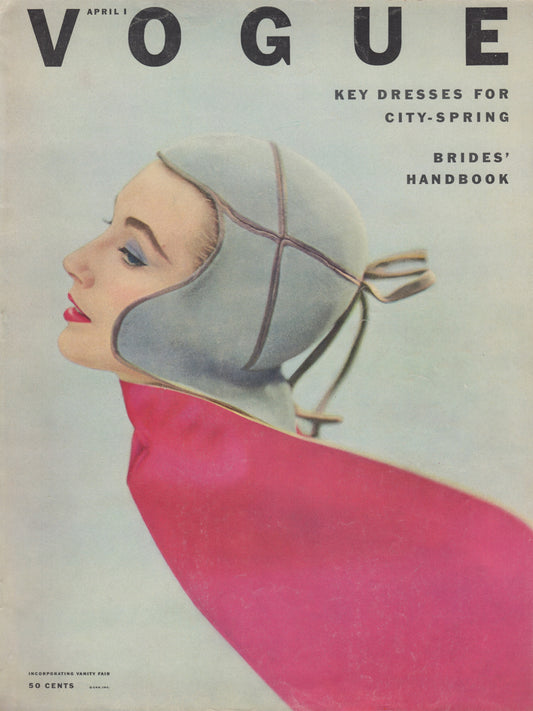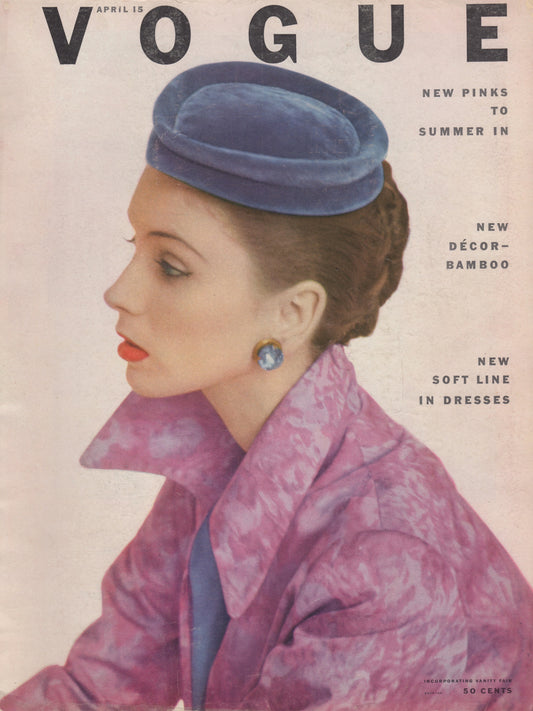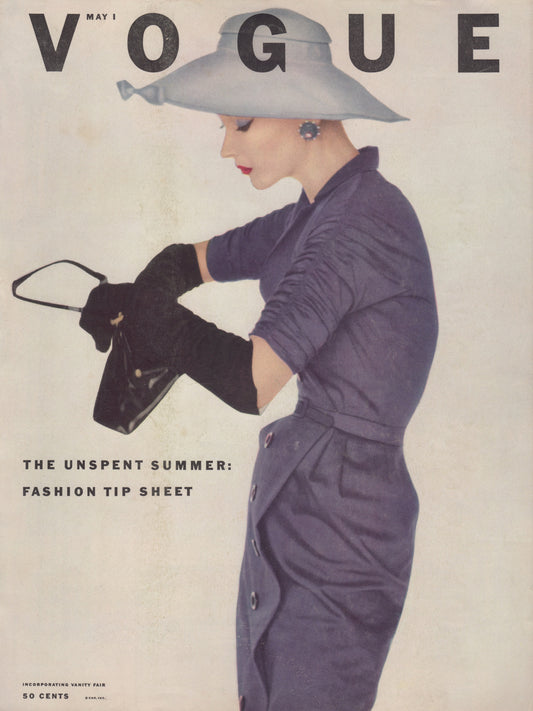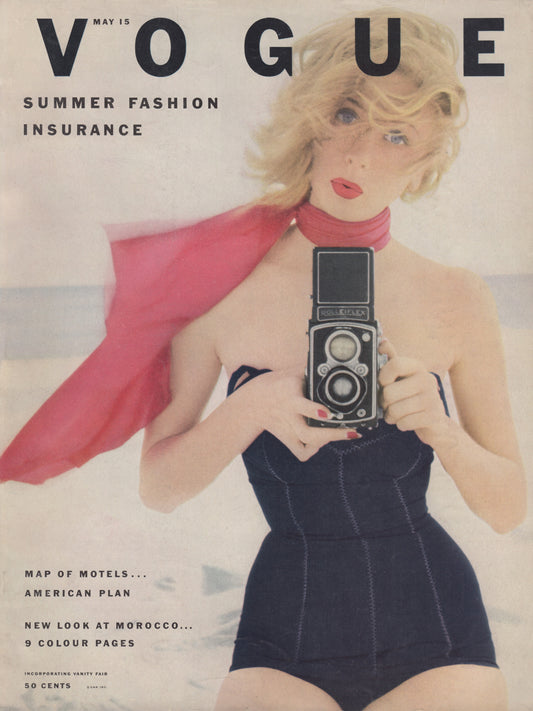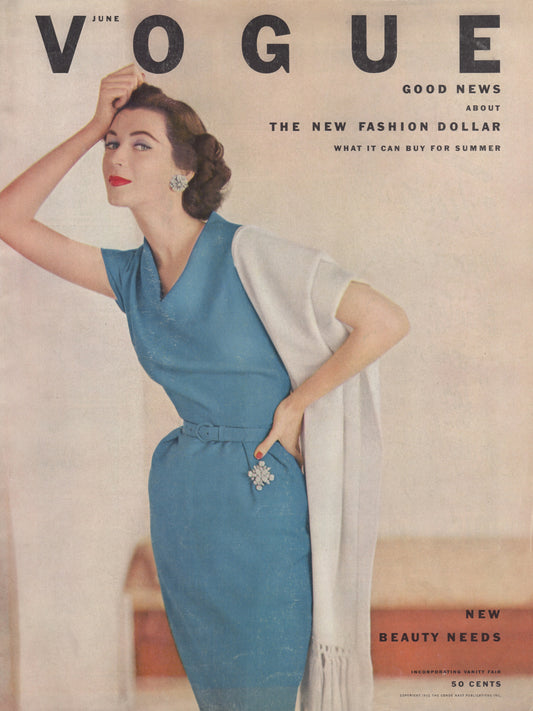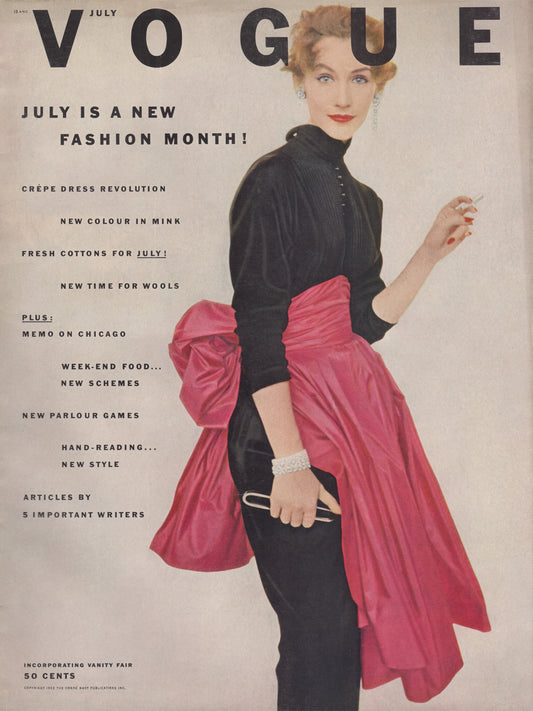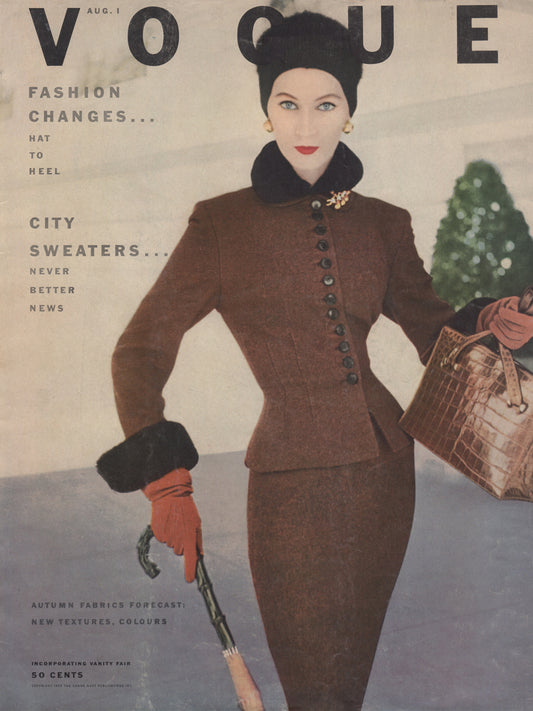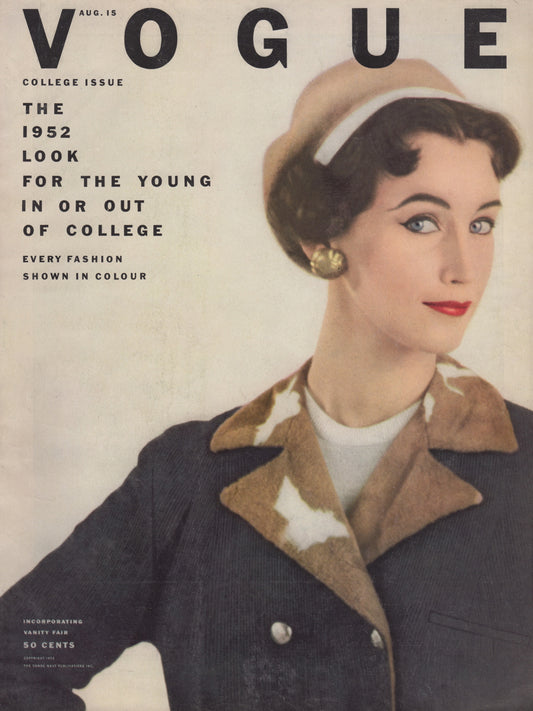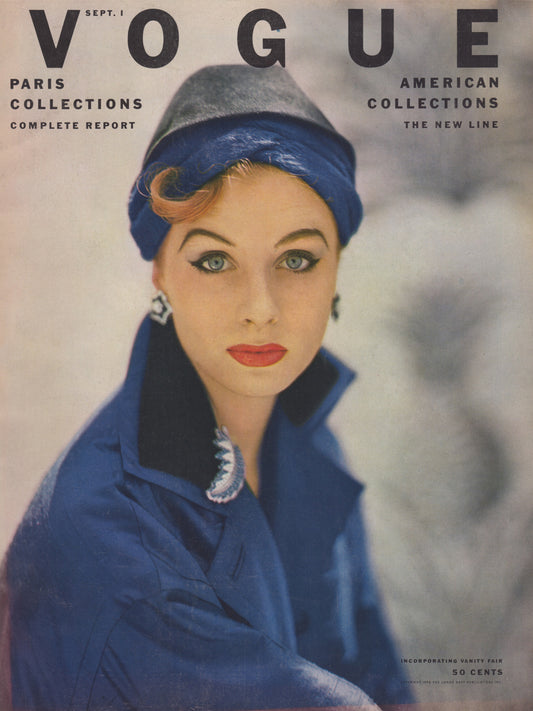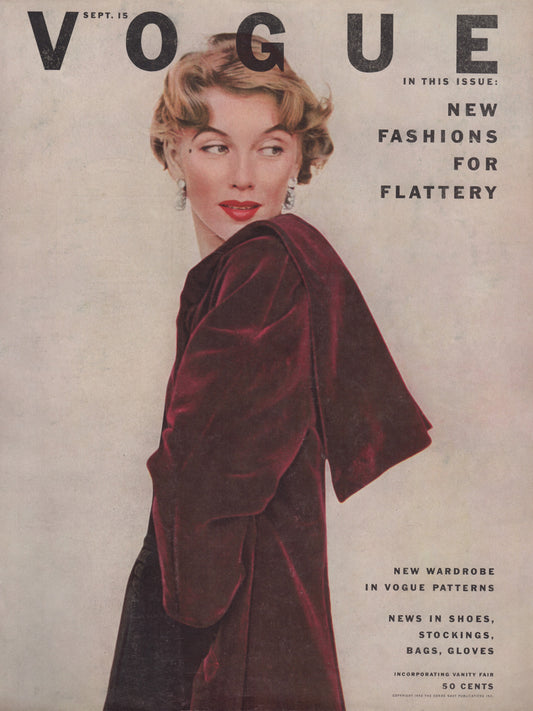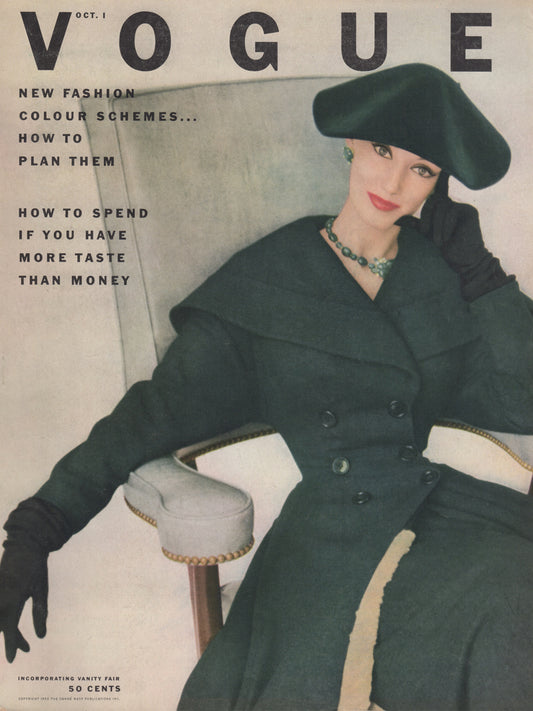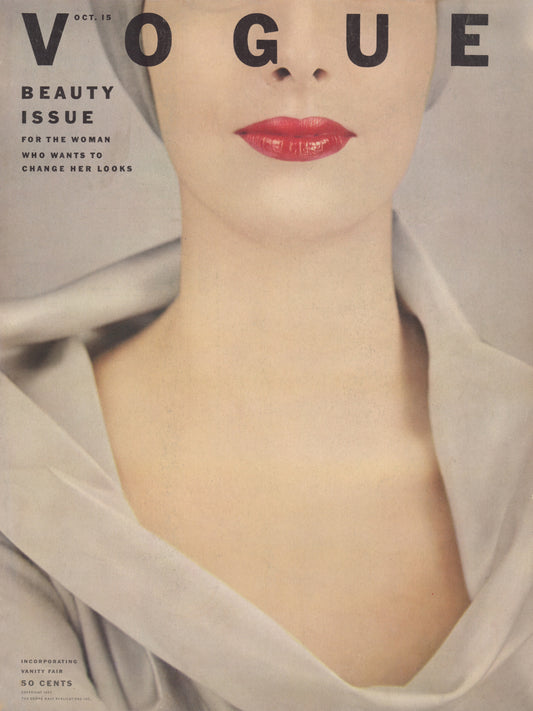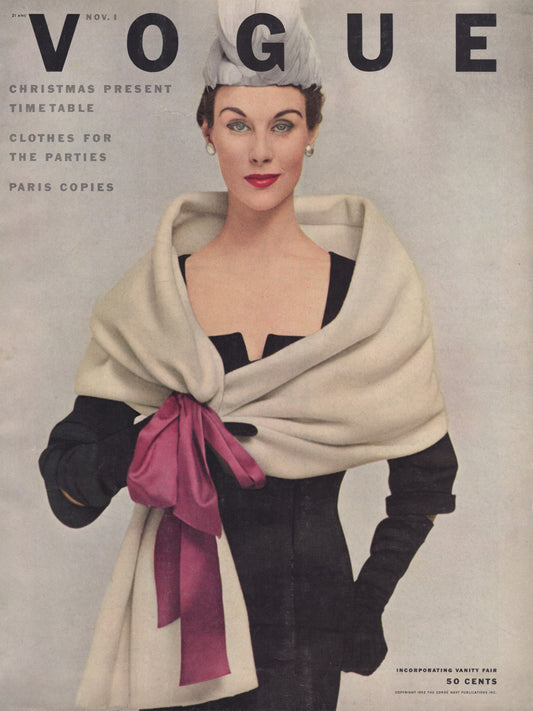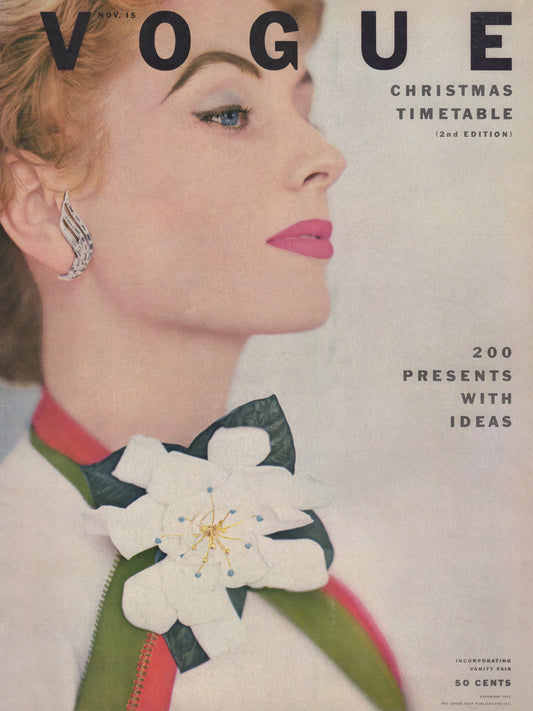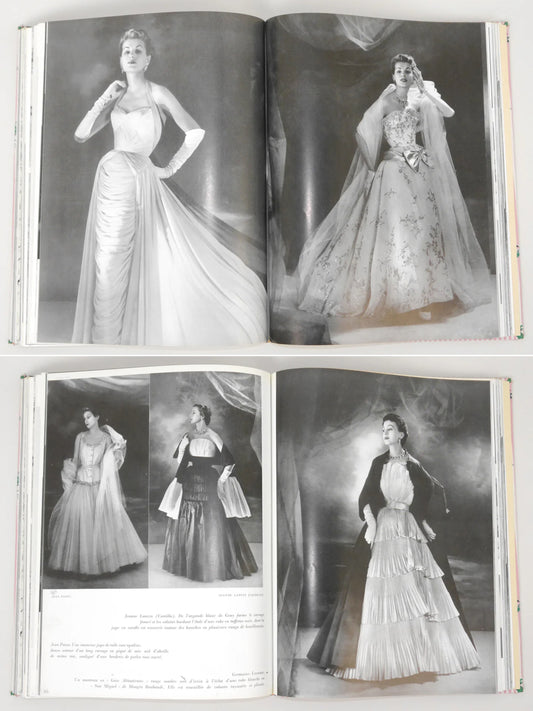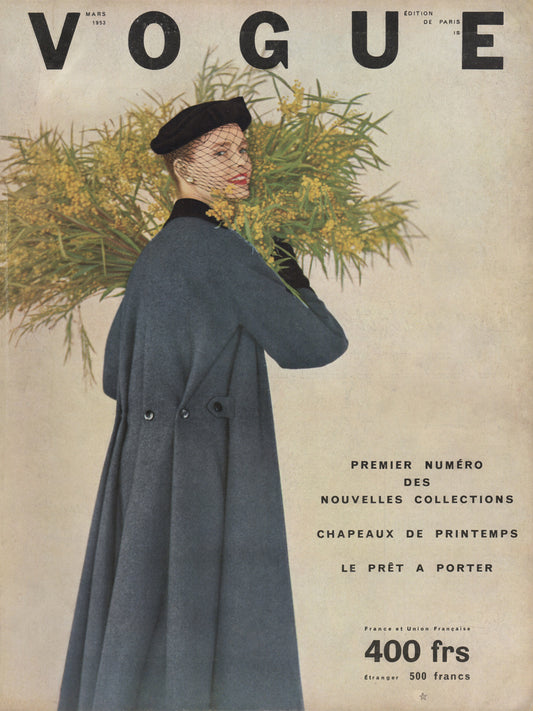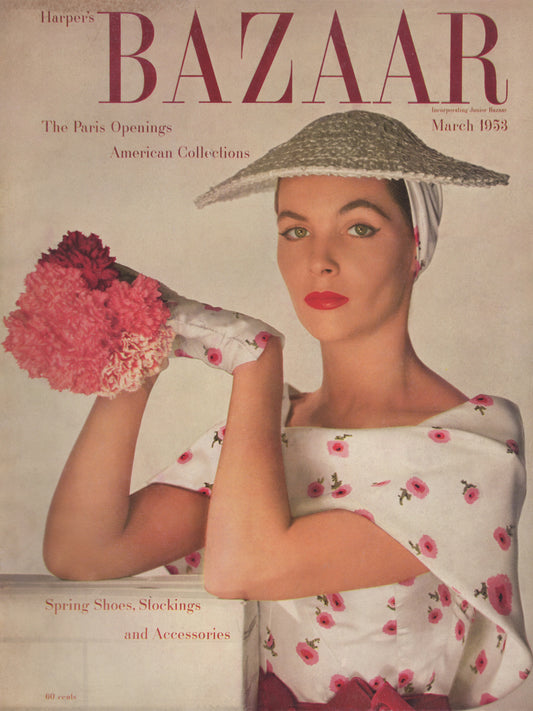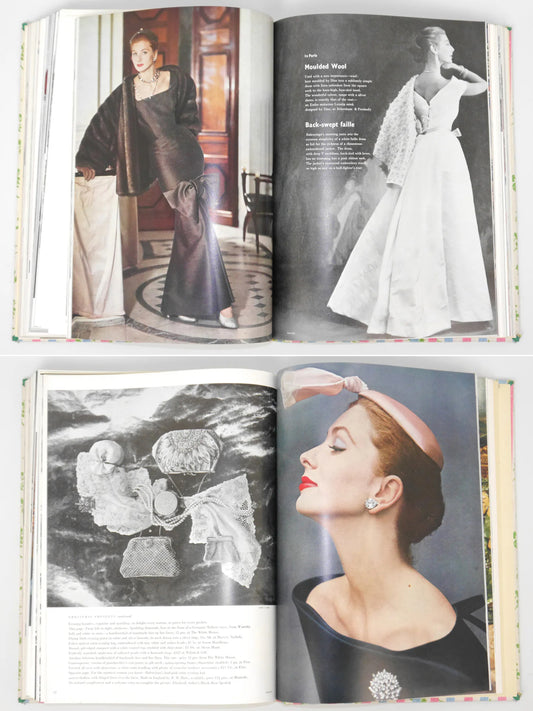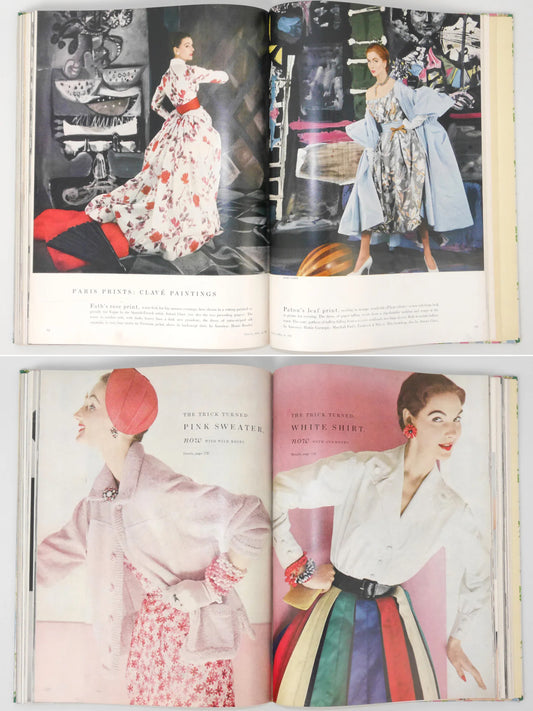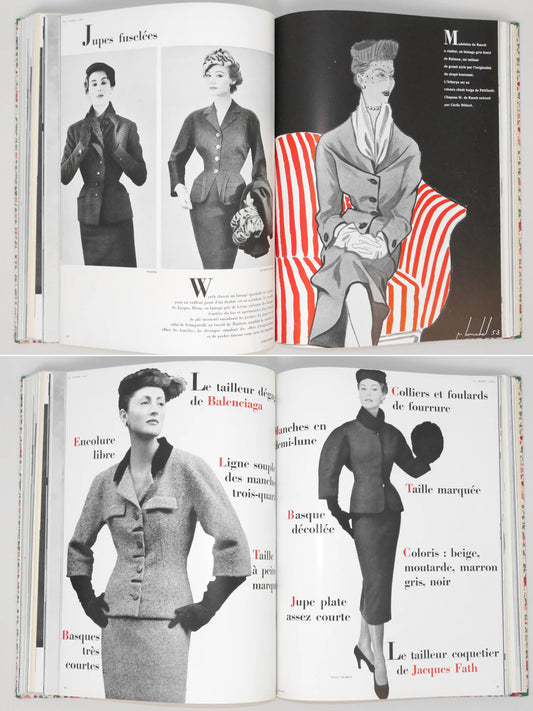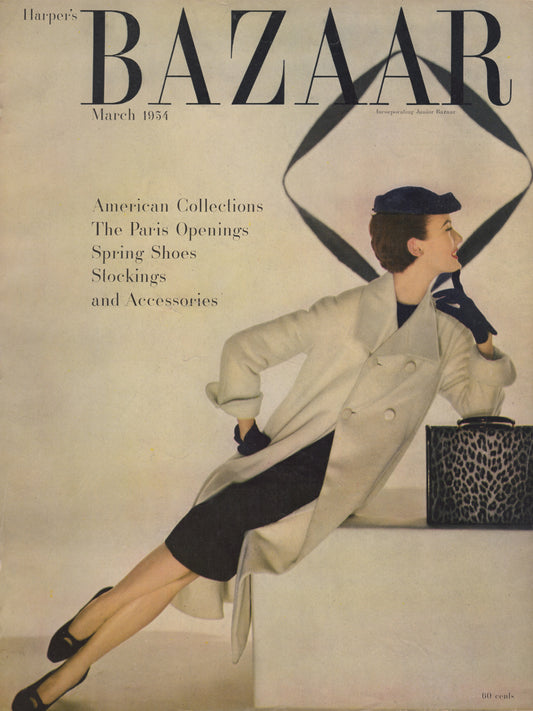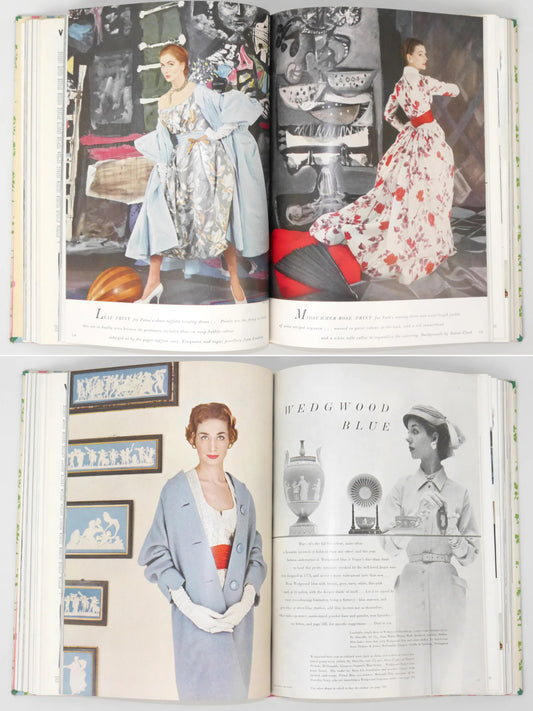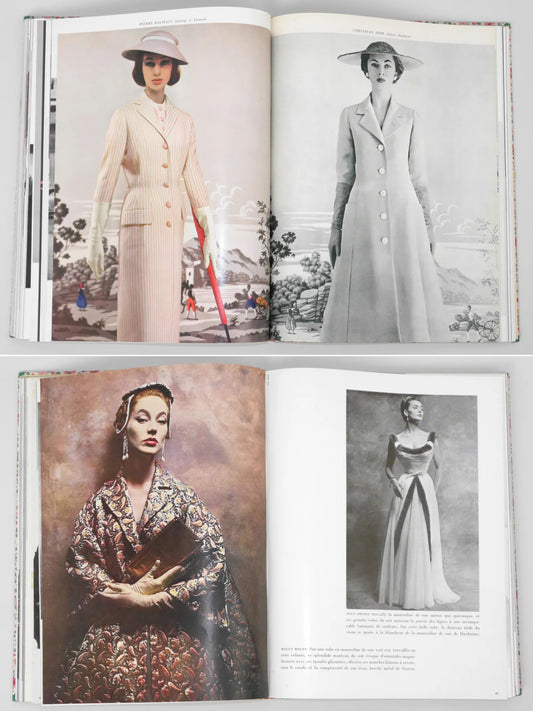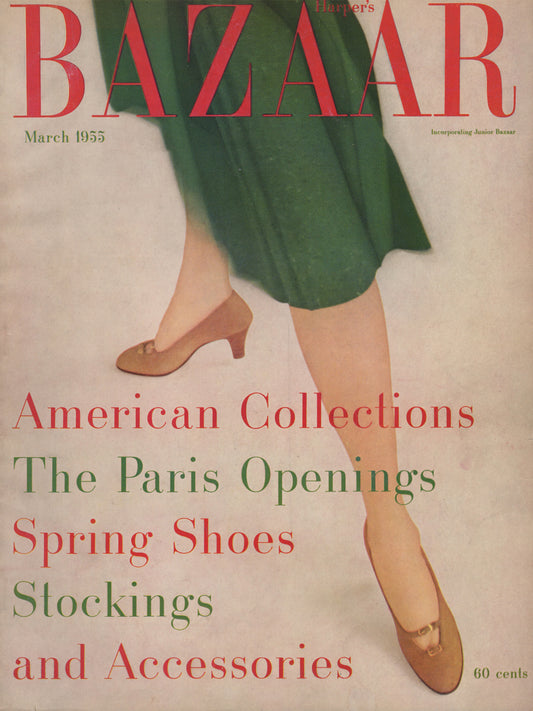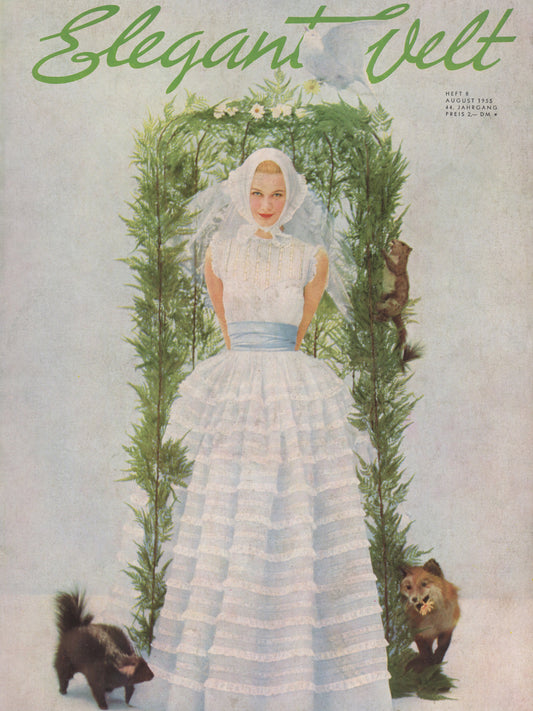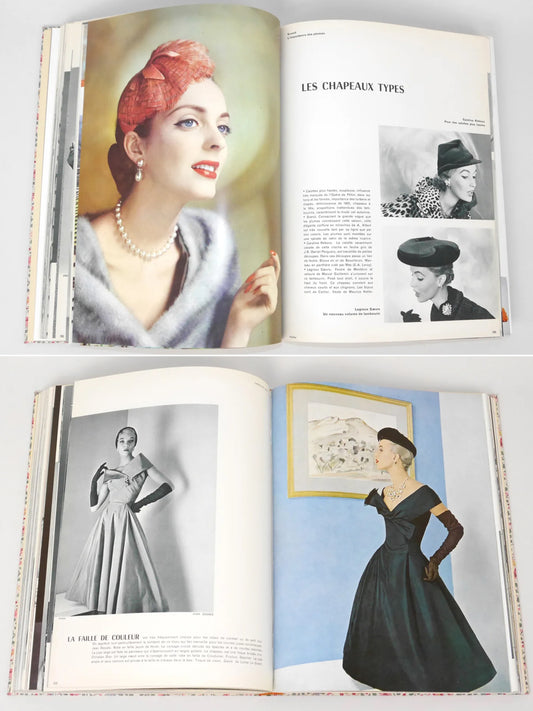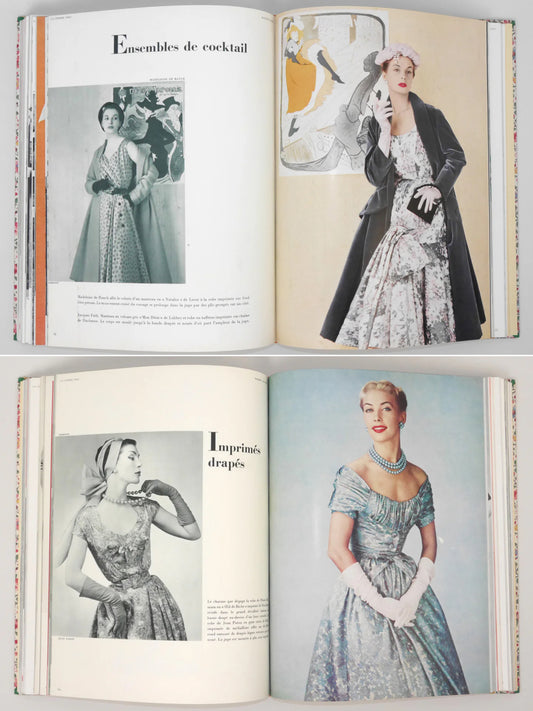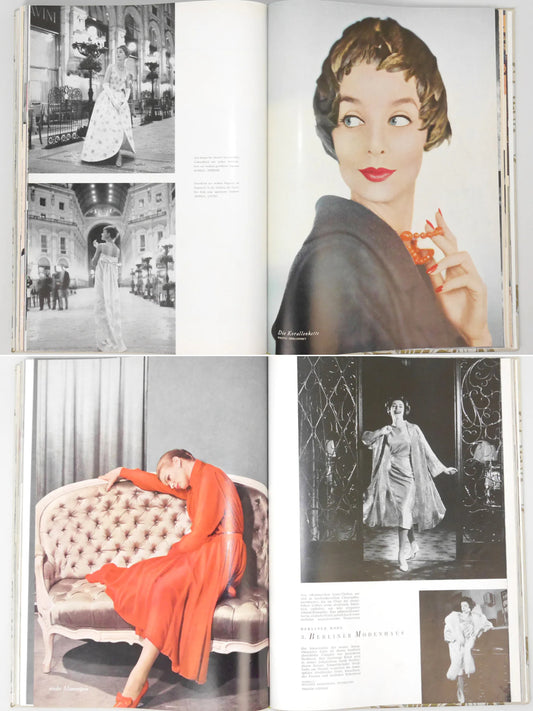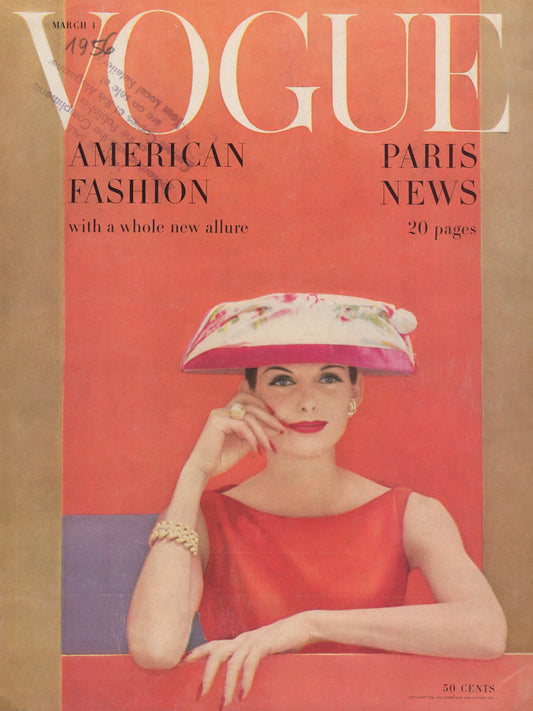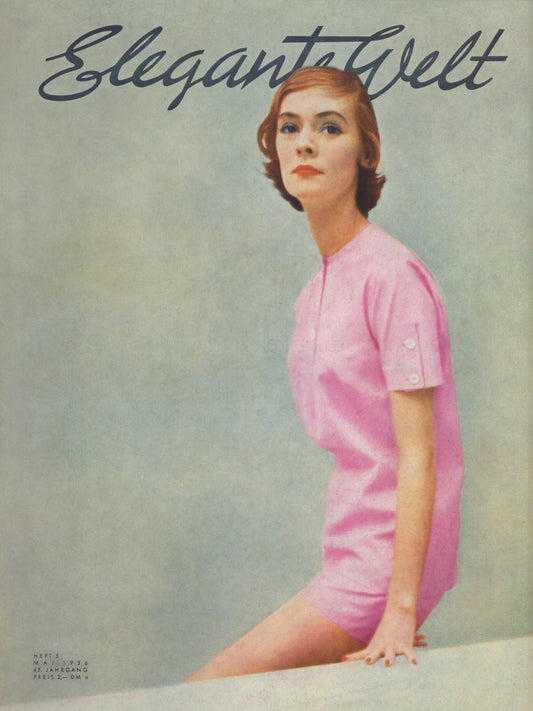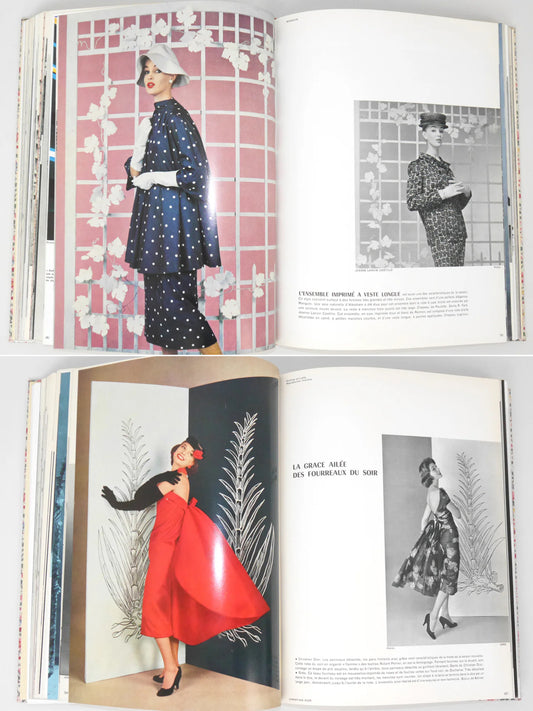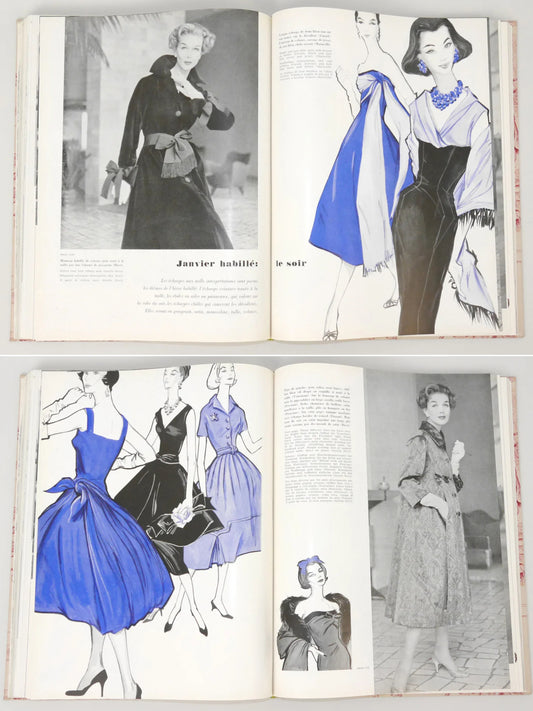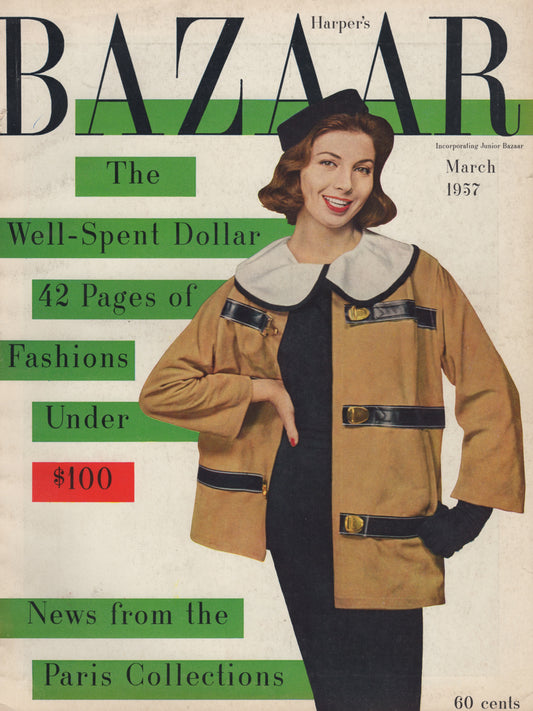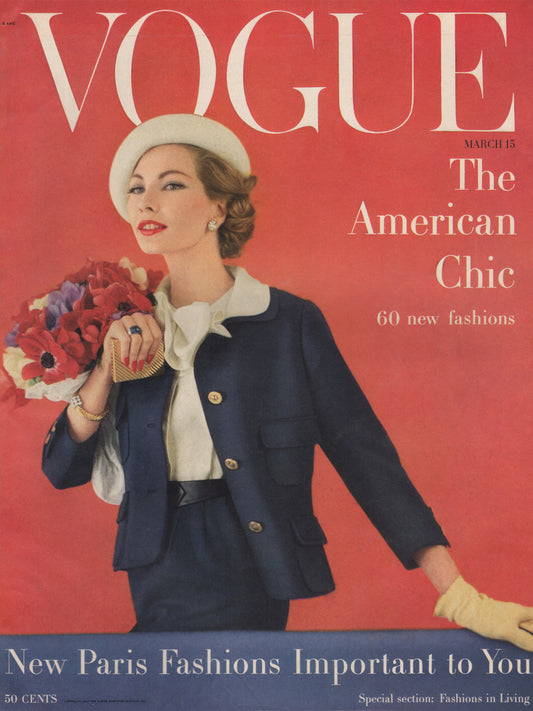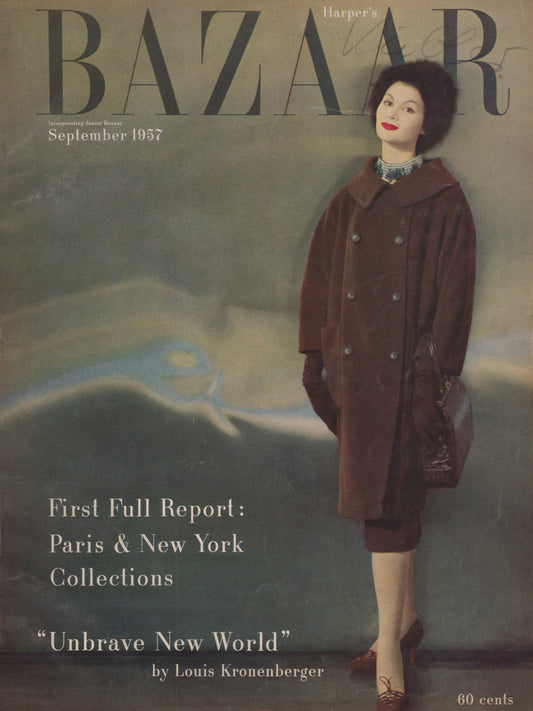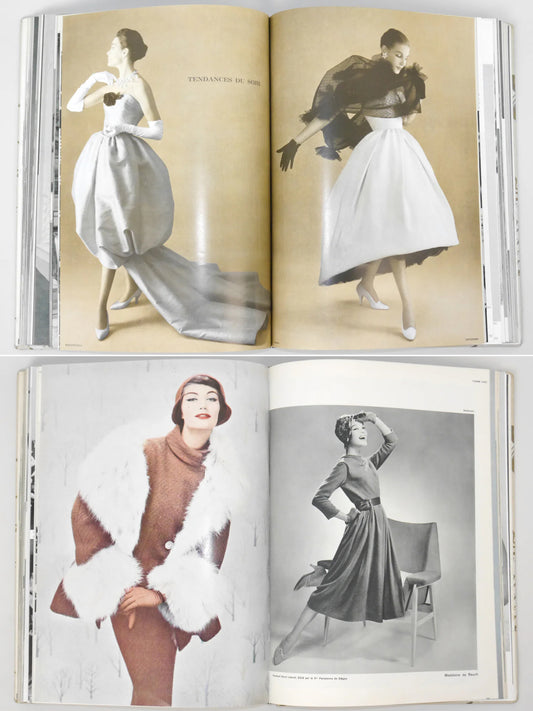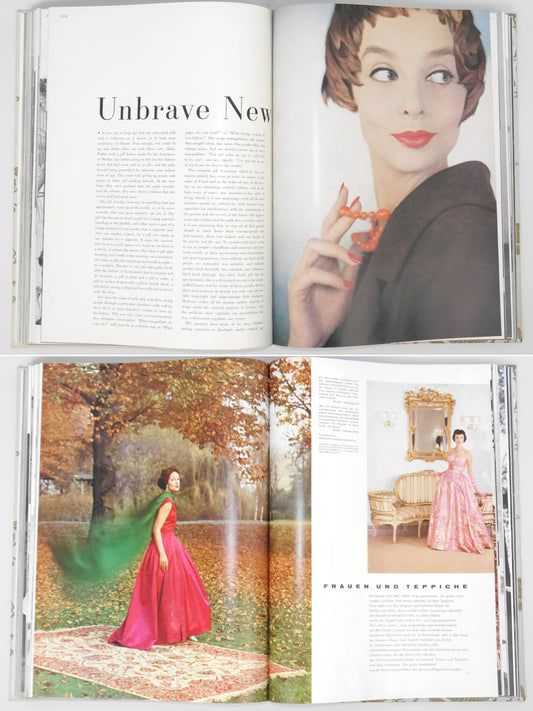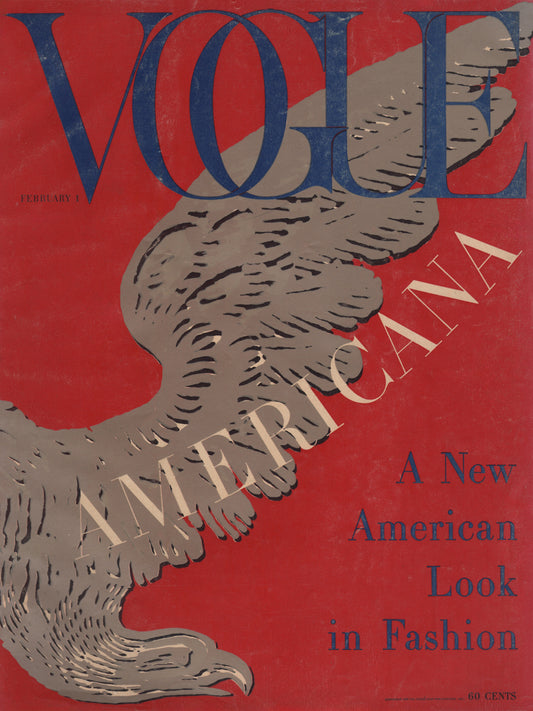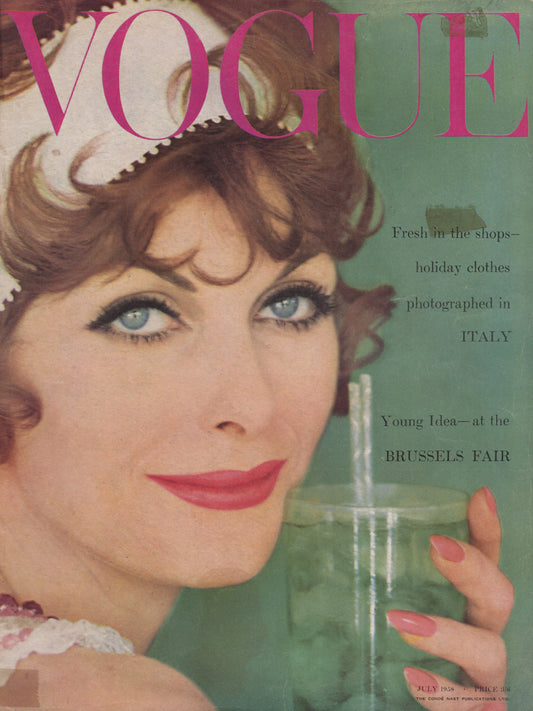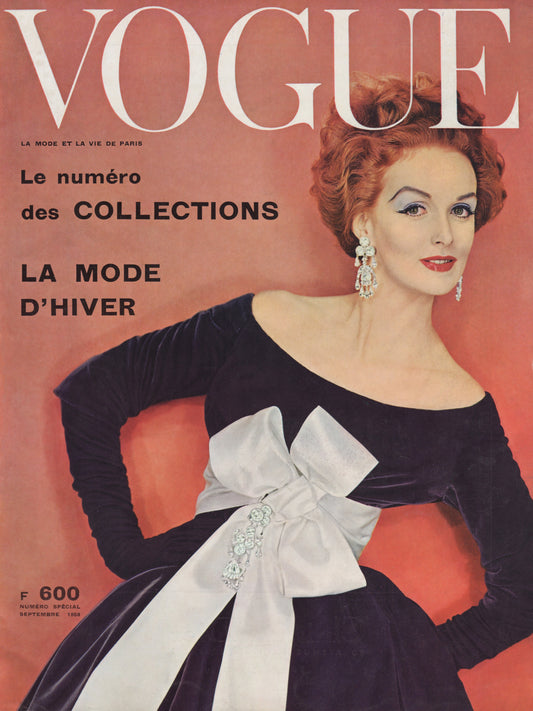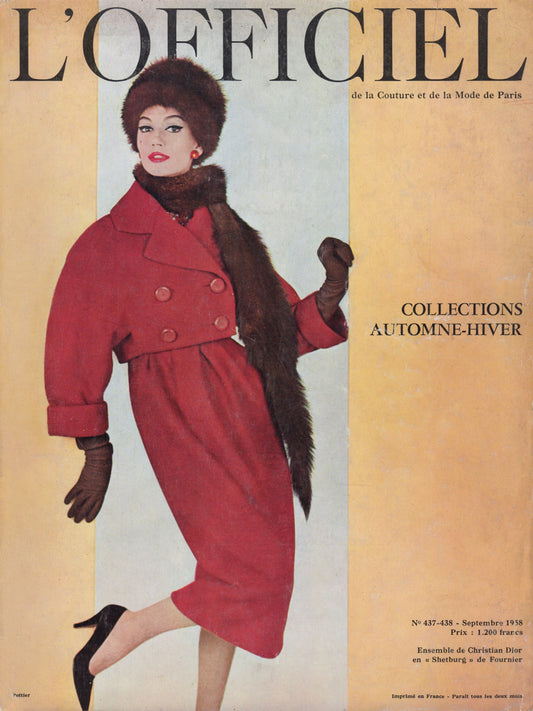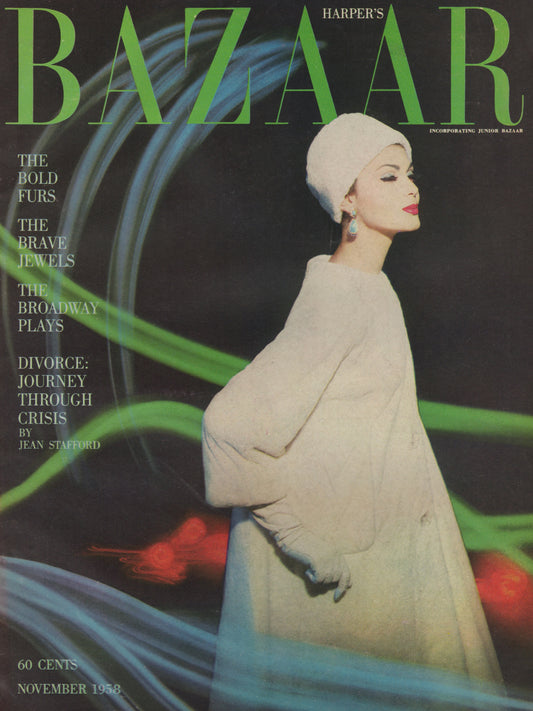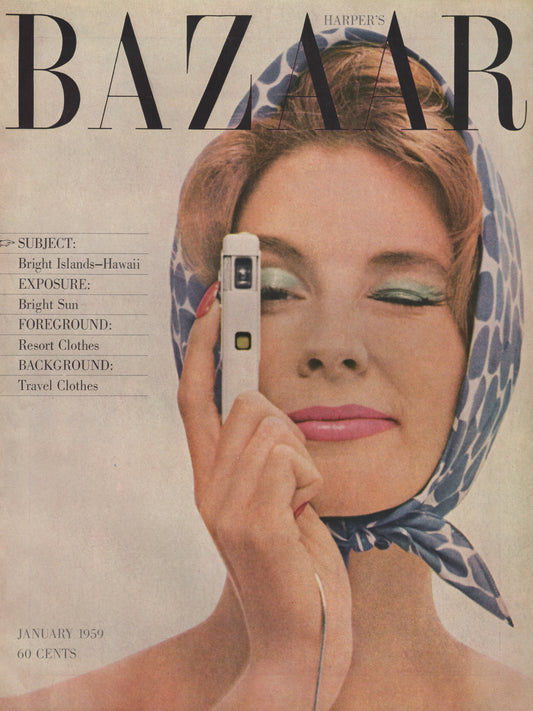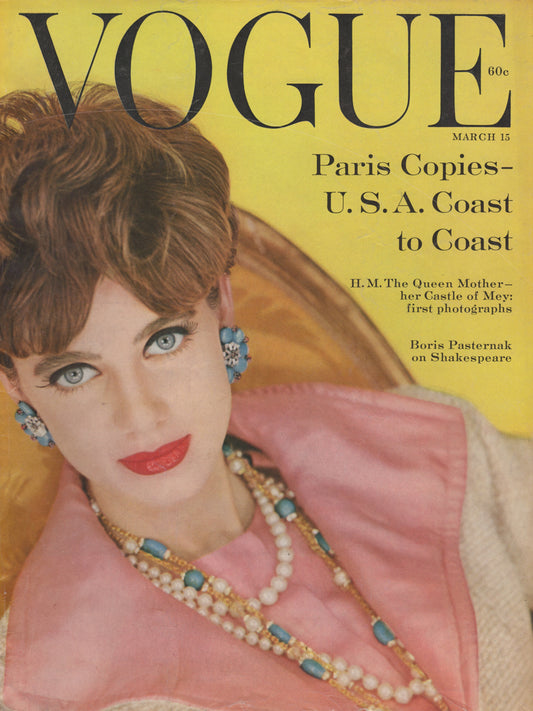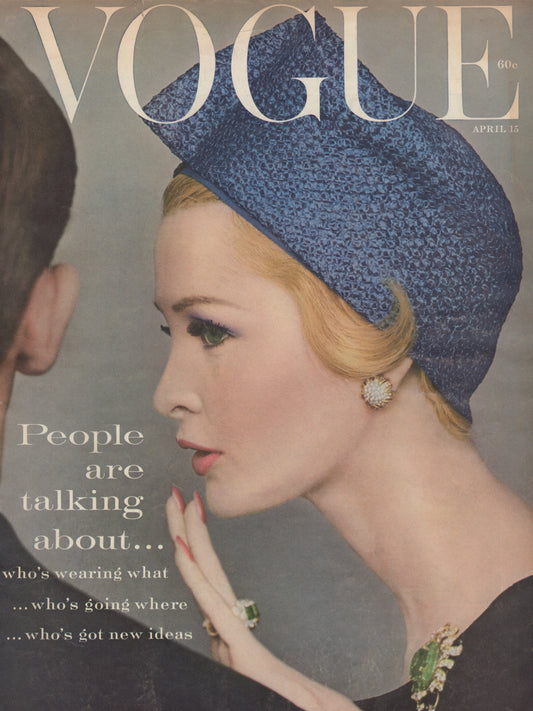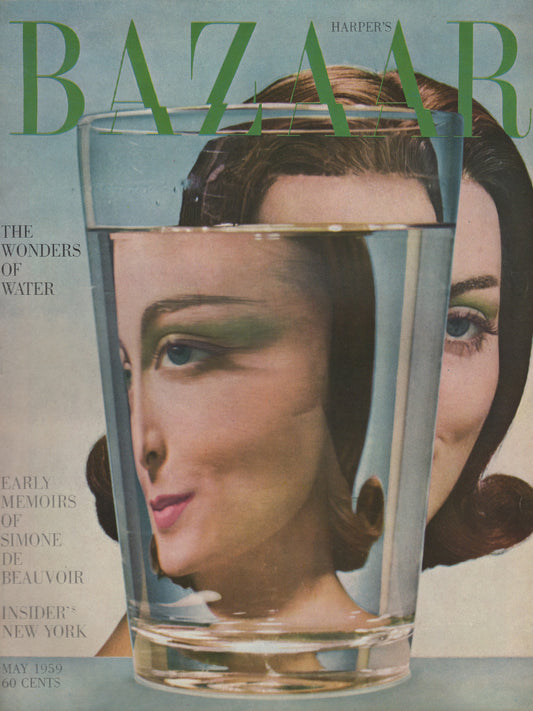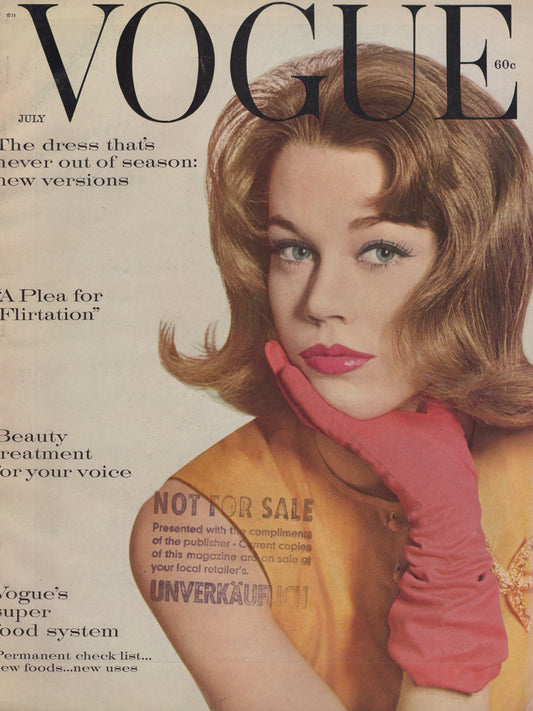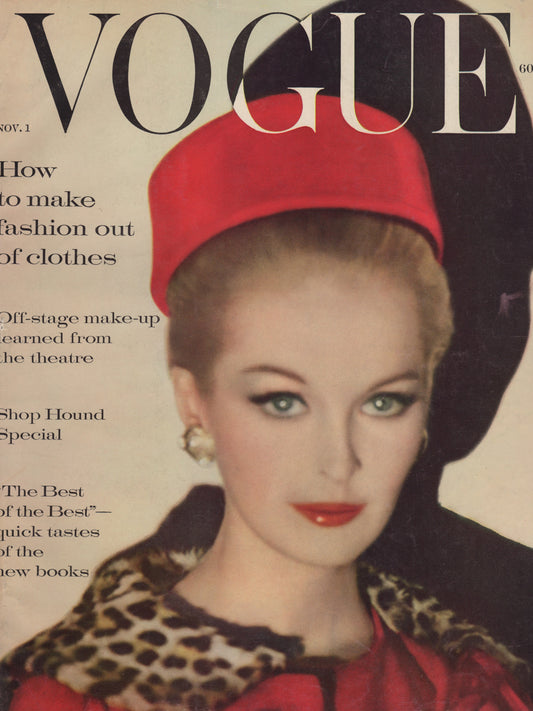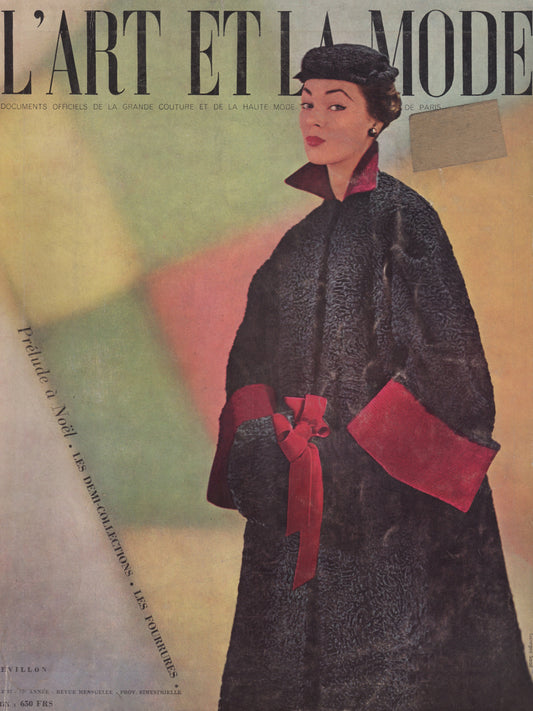Collection: FASHION MAGAZINES - 1950s
From Dior’s New Look to Pastel Dreams
The 1950s marked a transformative era in fashion, reflecting a collective yearning for femininity, elegance, and a return to polished glamour after the austerity of wartime styles. This decade saw fashion magazines like Vogue and Harper's Bazaar playing pivotal roles in shaping and promoting trends, highlighting the collections of iconic designers such as Christian Dior, Cristóbal Balenciaga, and Pierre Balmain. Collaborations with renowned photographers like Richard Avedon, Irving Penn, and Horst P. Horst elevated the visual artistry of editorial spreads, capturing the essence of 1950s fashion in stunning detail.
The defining silhouette of the era was characterized by voluminous, full skirts worn with crinolines or petticoats to achieve dramatic volume and movement. Christian Dior's groundbreaking "New Look," introduced in 1947, continued to dominate fashion, symbolizing a luxurious and glamorous return to femininity with its nipped-in waist and full skirts, celebrating the hourglass figure. While full skirts were a hallmark of the time, tailored suits and pencil skirts also gained prominence, offering women a streamlined, sophisticated alternative. Structured jackets, fitted waistlines, and slim-fitting skirts became wardrobe staples for the modern woman. For more casual occasions, twinsets - matching cardigans and tops - offered a chic yet comfortable option. Soft pastel hues, such as pink, mint green, baby blue, and lavender, became the colors of choice, often paired with floral prints and polka dots to create a romantic, feminine aesthetic. Accessories were integral to completing the polished look, with gloves, hats, and statement jewelry adding elegance to both formal and everyday outfits.
The makeup styles of the 1950s epitomized timeless glamour, emphasizing flawless, porcelain-like skin, bold red lipstick, dramatic winged eyeliner, and perfectly arched eyebrows. Supermodels of the decade, including Jean Patchett, Dovima, Suzy Parker, Mary Jane Russell, Sunny Harnett, and Lisa Fonssagrives, graced the pages of leading fashion magazines, embodying the beauty ideals of the time. Fashion icons such as Audrey Hepburn, Grace Kelly, and Brigitte Bardot set enduring standards of style, inspiring women not only in their era but for generations to come. The 1950s remain a defining decade, celebrated for its iconic designs and timeless elegance that continue to influence fashion today.
-
Bound Vintage Fashion Magazine Issues - VOGUE UK 1949 & 1950, FIGARO Germany 1950
Regular price 395 €Regular price -
HARPER'S BAZAAR UK May 1950
Regular price 250 €Regular price -
Bound Vintage Fashion Magazine Issues - VOGUE UK 1950 & 1955
Regular price 395 €Regular price -
VOGUE US March 15, 1951
Regular price 180 €Regular price -
L'OFFICIEL PARIS April 1951
Regular price 325 €Regular price -
VOGUE US April 1, 1951
Regular price 225 €Regular price -
ELEGANTE WELT October 1951
Regular price 160 €Regular price -
Bound Vintage Fashion Magazine Issues - L'ALBUM DU FIGARO 1951, 1952, 1953, 1954
Regular price 395 €Regular price -
British VOGUE UK January 1952
Regular price 250 €Regular price -
VOGUE US February 1, 1952
Regular price 150 €Regular price -
VOGUE US March 1, 1952
Regular price 280 €Regular price -
VOGUE US April 1, 1952
Regular price 260 €Regular price -
VOGUE US April 15, 1952
Regular price 295 €Regular price -
VOGUE US May 1, 1952
Regular price 260 €Regular price -
VOGUE US May 15, 1952
Regular price 220 €Regular price -
VOGUE US June 1952
Regular price 220 €Regular price -
VOGUE US July 1952
Regular price 235 €Regular price -
VOGUE US August 1, 1952
Regular price 150 €Regular price -
VOGUE US August 15, 1952
Regular price 260 €Regular price -
VOGUE US September 1, 1952
Regular price 325 €Regular price -
VOGUE US September 15, 1952
Regular price 250 €Regular price -
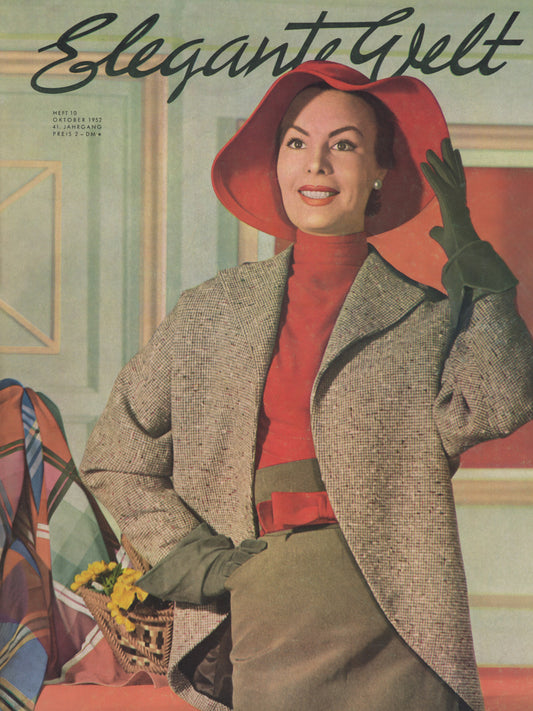 Sold out
Sold outELEGANTE WELT October 1952
Regular price 160 €Regular price -
VOGUE US October 1, 1952
Regular price 200 €Regular price -
VOGUE US October 15, 1952
Regular price 295 €Regular price -
VOGUE US November 1, 1952
Regular price 325 €Regular price -
VOGUE US November 15, 1952
Regular price 295 €Regular price -
Bound Vintage Fashion Magazine Issues - L'ART ET LA MODE 1952, 1953, 1954
Regular price 495 €Regular price -
VOGUE Paris March 1953
Regular price 325 €Regular price -
HARPER'S BAZAAR US March 1953
Regular price 250 €Regular price -
Bound Vintage Fashion Magazine Issues - VOGUE UK 1953
Regular price 495 €Regular price -
Bound Vintage Fashion Magazine Issues - VOGUE US 1953 & 1954
Regular price 395 €Regular price -
Bound Vintage Fashion Magazine Issues - FEMME CHIC 1953 1954
Regular price 425 €Regular price -
British VOGUE UK March 1954
Regular price 260 €Regular price -
HARPER'S BAZAAR US March 1954
Regular price 250 €Regular price -
Bound Vintage Fashion Magazine Issues - VOGUE UK 1954
Regular price 495 €Regular price -
Bound Vintage Fashion Magazine Issues - SILHOUETTE 1954 1955
Regular price 395 €Regular price -
British VOGUE UK January 1955
Regular price 180 €Regular price -
HARPER'S BAZAAR US March 1955
Regular price 250 €Regular price -
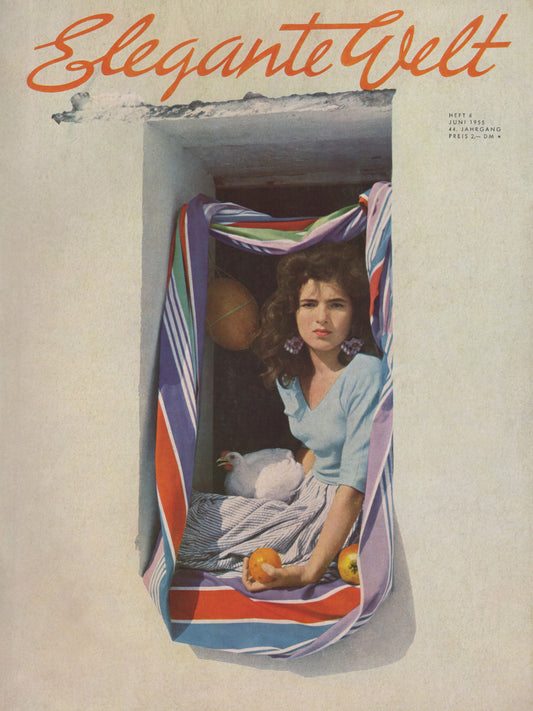 Sold out
Sold outELEGANTE WELT June 1955
Regular price 160 €Regular price -
ELEGANTE WELT August 1955
Regular price 180 €Regular price -
Bound Vintage Fashion Magazine Issues - L'OFFICIEL PARIS 1955
Regular price 495 €Regular price -
Bound Vintage Fashion Magazine Issues - FEMME CHIC 1955
Regular price 395 €Regular price -
Bound Vintage Fashion Magazine Issues - ELEGANTE WELT 1955, 1956, 1957, 1958
Regular price 425 €Regular price -
VOGUE US March 1, 1956
Regular price 180 €Regular price -
ELEGANTE WELT May 1956
Regular price 180 €Regular price -
Bound Vintage Fashion Magazine Issues - L'OFFICIEL PARIS 1956
Regular price 495 €Regular price -
Bound Vintage Fashion Magazine Issues - COLLECTIONS & LA DONNA 1956, 1957, 1958
Regular price 375 €Regular price -
HARPER'S BAZAAR US March 1957
Regular price 250 €Regular price -
VOGUE US March 15, 1957
Regular price 175 €Regular price -
HARPER'S BAZAAR US September 1957
Regular price 250 €Regular price -
Bound Vintage Fashion Magazine Issues - L'OFFICIEL & FEMME CHIC 1957 1958
Regular price 395 €Regular price -
Bound Vintage Fashion Magazine Issues - ELEGANTE WELT, MADAME, CHIC, HARPER'S BAZAAR US 1957 1958
Regular price 650 €Regular price -
VOGUE US February 1, 1958
Regular price 180 €Regular price -
British VOGUE UK July 1958
Regular price 175 €Regular price -
VOGUE Paris September 1958
Regular price 300 €Regular price -
L'OFFICIEL PARIS September 1958
Regular price 300 €Regular price -
HARPER'S BAZAAR US November 1958
Regular price 250 €Regular price -
HARPER'S BAZAAR US January 1959
Regular price 250 €Regular price -
VOGUE US March 15, 1959
Regular price 175 €Regular price -
VOGUE US April 15, 1959
Regular price 180 €Regular price -
HARPER'S BAZAAR US May 1959
Regular price 325 €Regular price -
VOGUE US July 1959
Regular price 175 €Regular price -
VOGUE US November 1, 1959
Regular price 270 €Regular price -
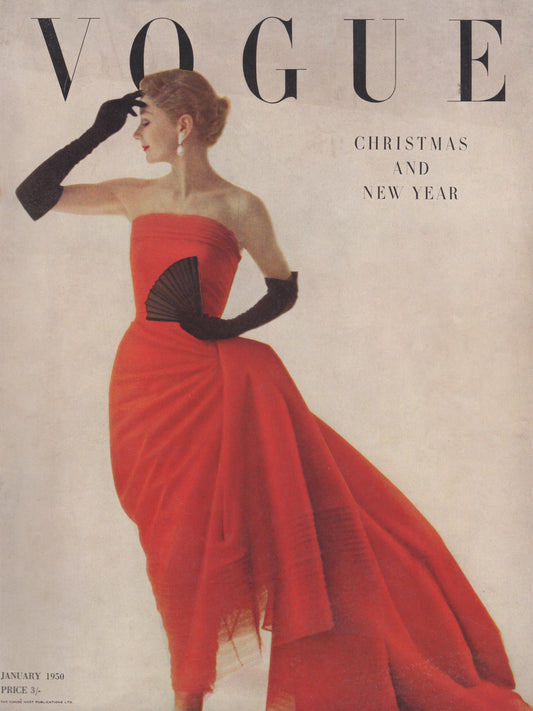 Sold out
Sold outBritish VOGUE UK January 1950
Regular price 0 €Regular price -
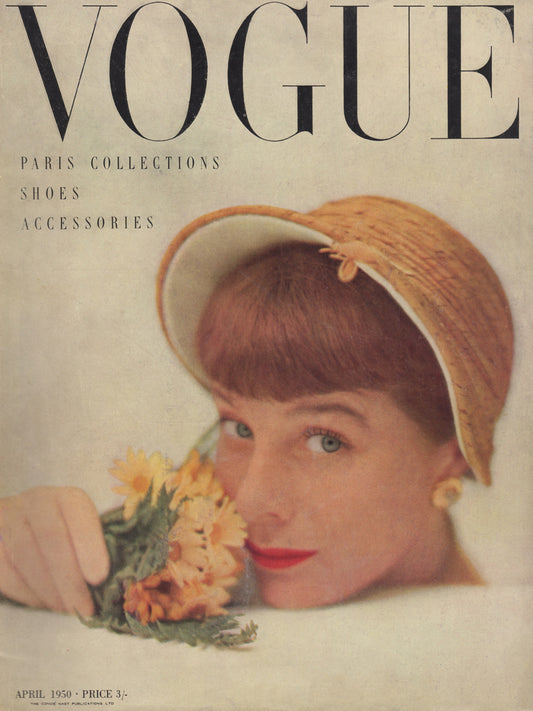 Sold out
Sold outBritish VOGUE UK April 1950
Regular price 0 €Regular price -
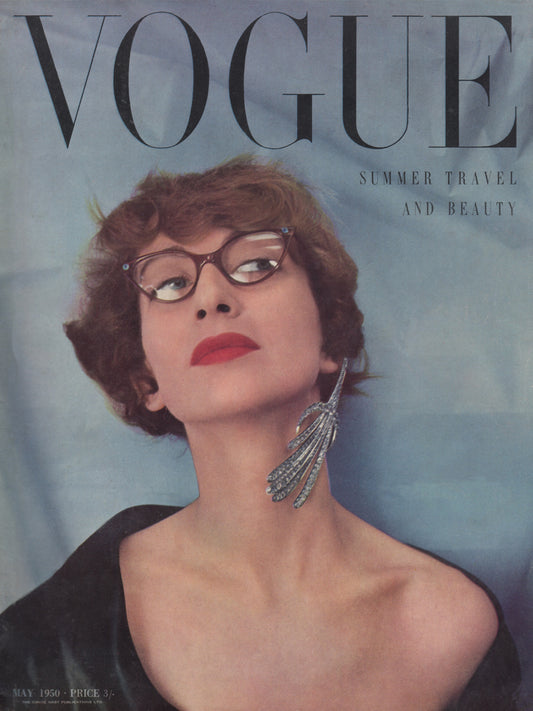 Sold out
Sold outBritish VOGUE UK May 1950
Regular price 0 €Regular price -
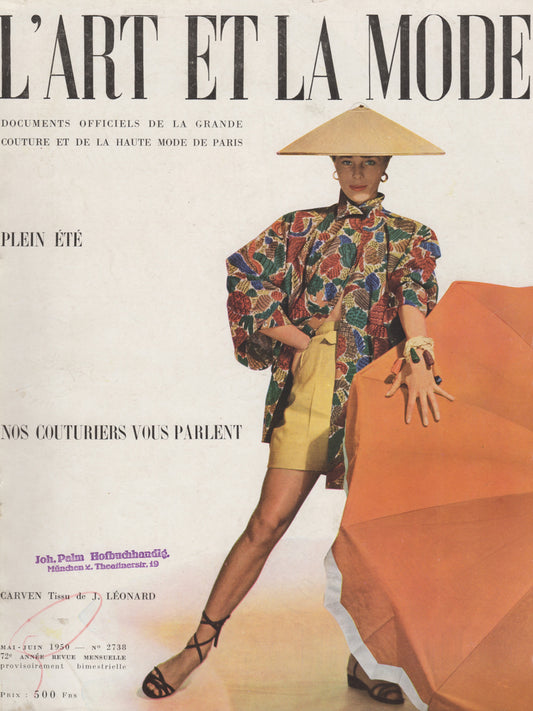 Sold out
Sold outL'ART ET LA MODE May/June 1950
Regular price 0 €Regular price -
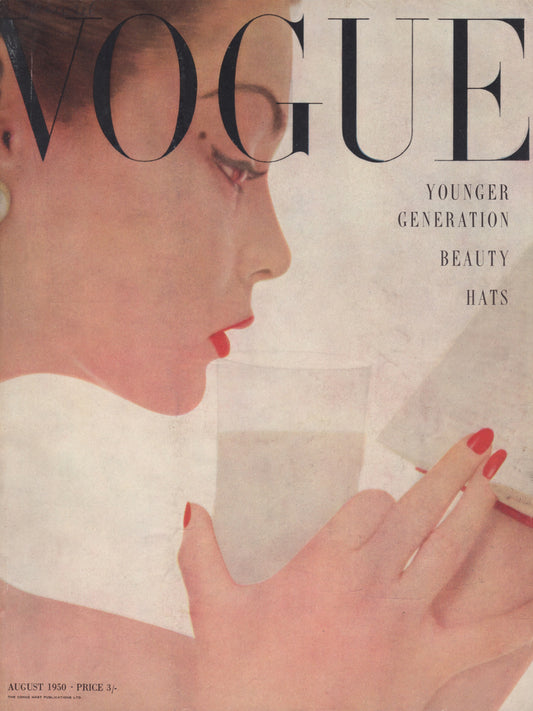 Sold out
Sold outBritish VOGUE UK August 1950
Regular price 205 €Regular price -
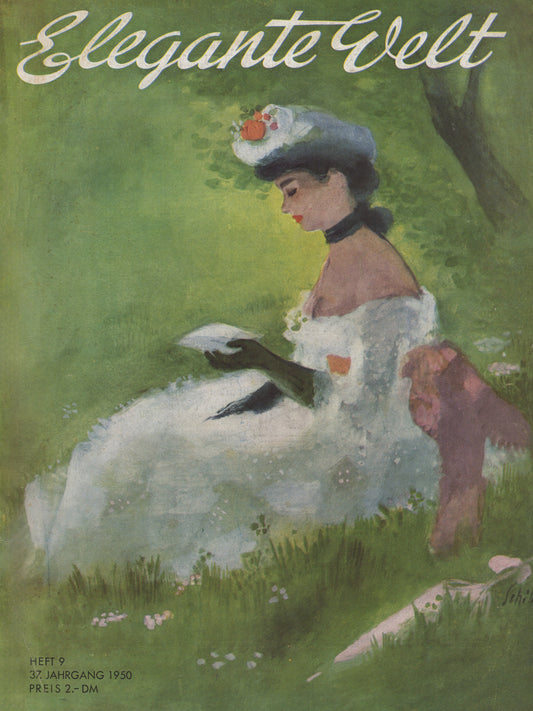 Sold out
Sold outELEGANTE WELT September 1950
Regular price 0 €Regular price -
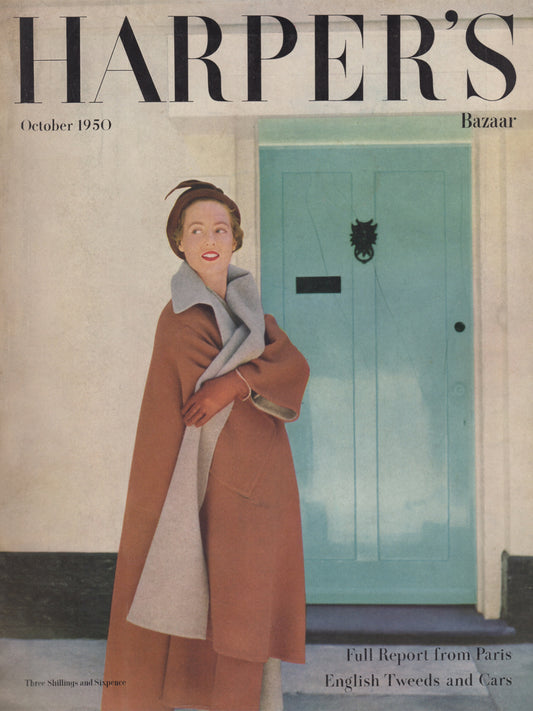 Sold out
Sold outHARPER'S BAZAAR UK October 1950
Regular price 0 €Regular price -
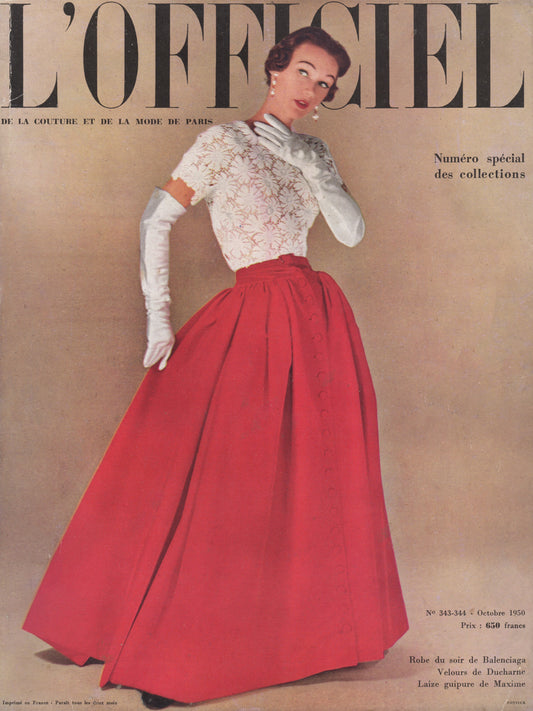 Sold out
Sold outL'OFFICIEL PARIS October 1950
Regular price 0 €Regular price -
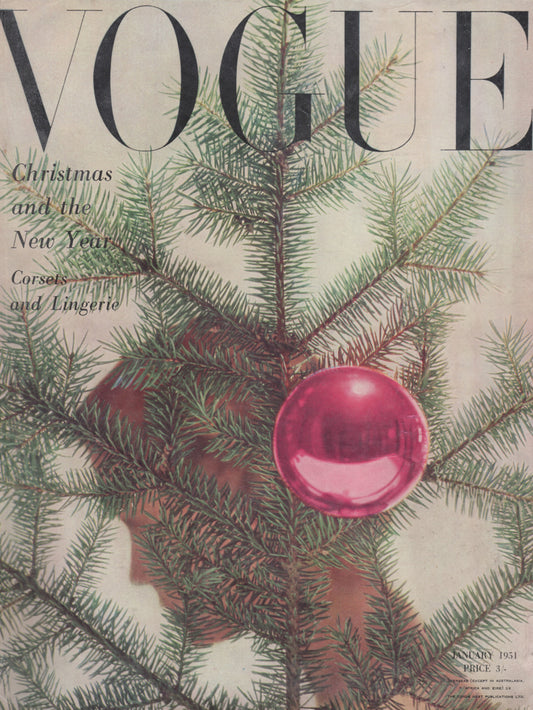 Sold out
Sold outBritish VOGUE UK January 1951
Regular price 0 €Regular price -
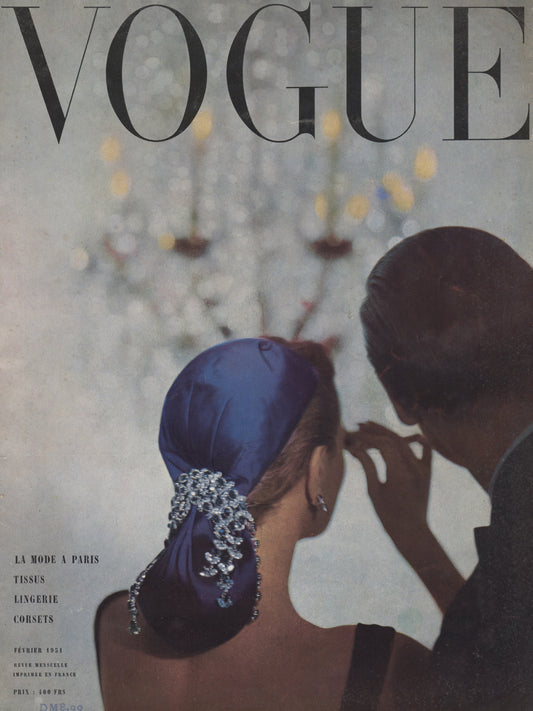 Sold out
Sold outVOGUE Paris February 1951
Regular price 0 €Regular price -
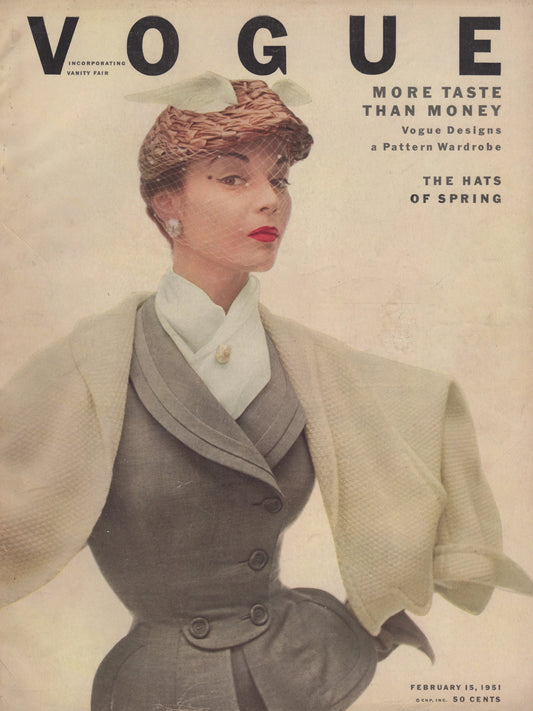 Sold out
Sold outVOGUE US February 15, 1951
Regular price 250 €Regular price -
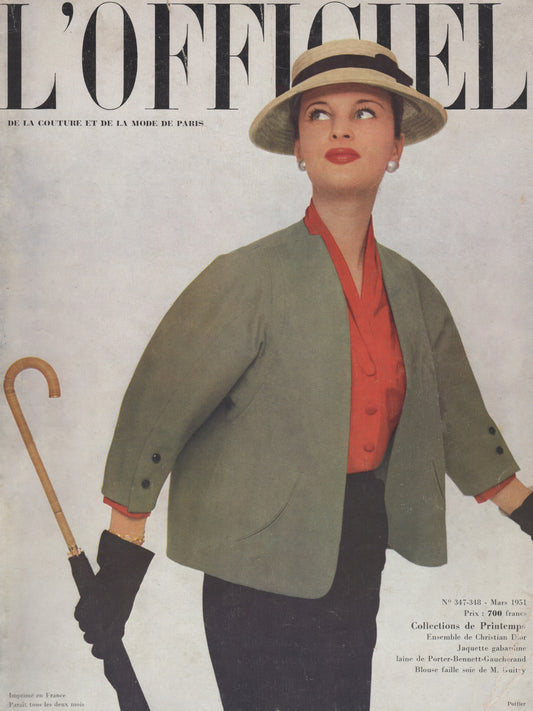 Sold out
Sold outL'OFFICIEL PARIS March 1951
Regular price 0 €Regular price -
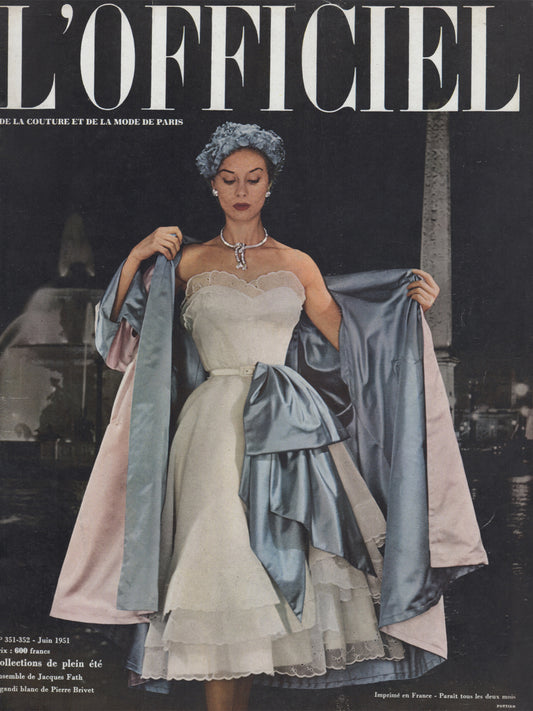 Sold out
Sold outL'OFFICIEL PARIS June 1951
Regular price 0 €Regular price -
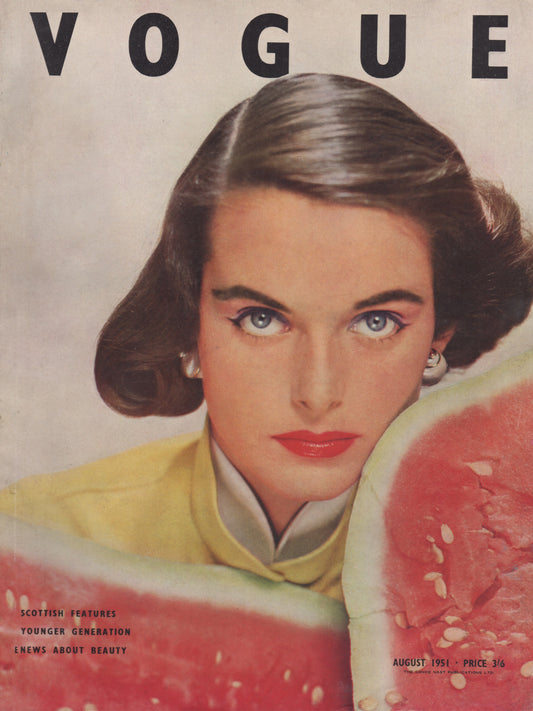 Sold out
Sold outBritish VOGUE UK August 1951
Regular price 180 €Regular price -
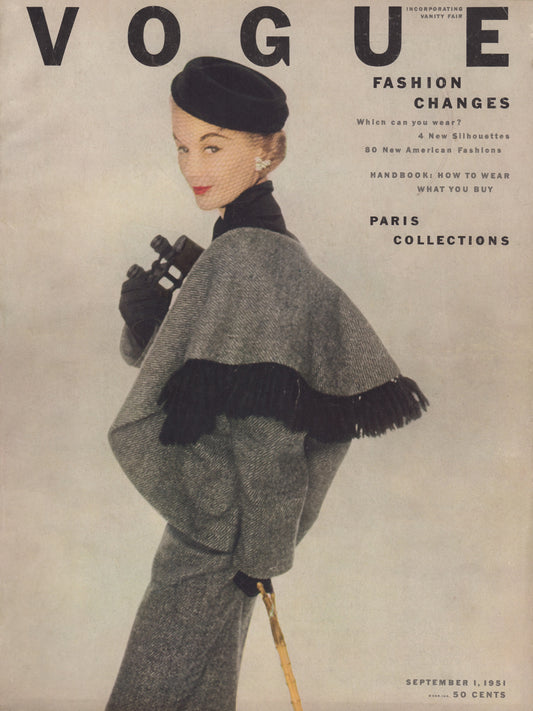 Sold out
Sold outVOGUE US September 1, 1951
Regular price 0 €Regular price -
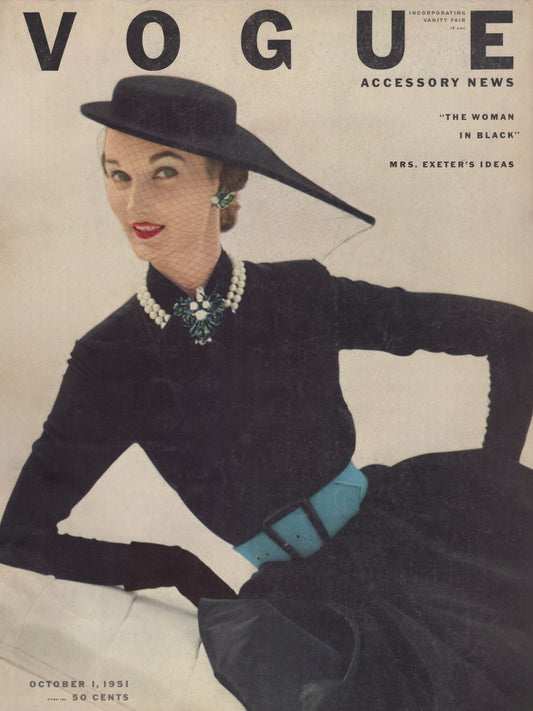 Sold out
Sold outVOGUE US October 1, 1951
Regular price 0 €Regular price -
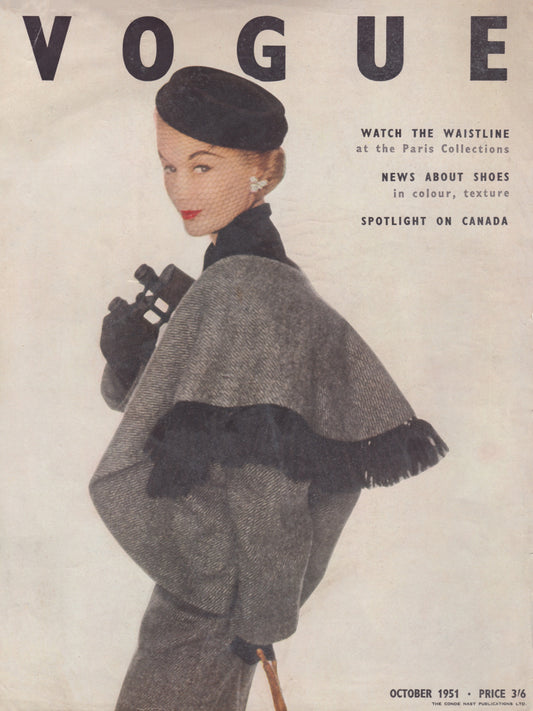 Sold out
Sold outBritish VOGUE UK October 1951
Regular price 0 €Regular price -
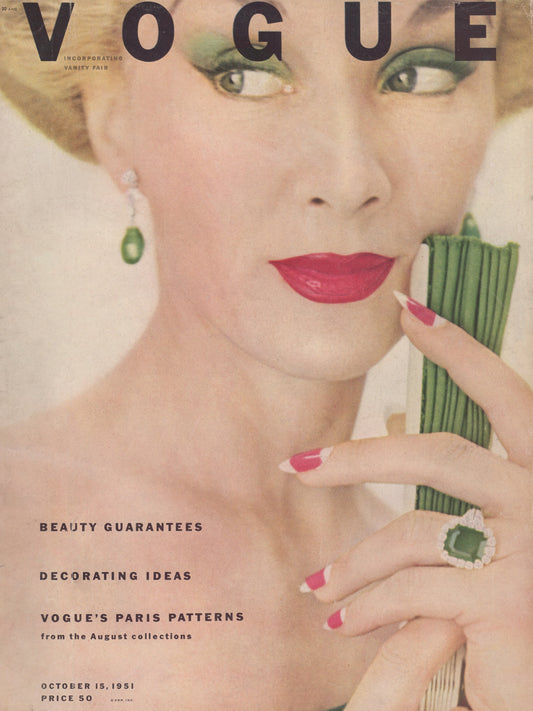 Sold out
Sold outVOGUE US October 15, 1951
Regular price 0 €Regular price -
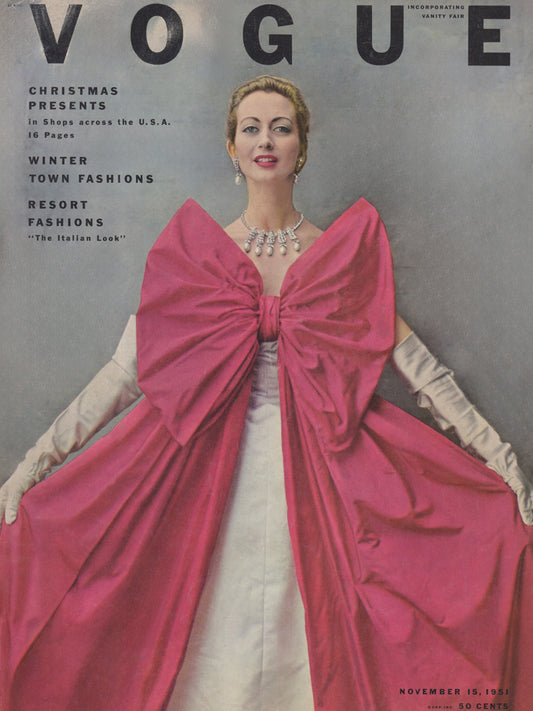 Sold out
Sold outVOGUE US November 15, 1951
Regular price 0 €Regular price -
L'ART ET LA MODE December 1951/January 1952
Regular price 0 €Regular price -
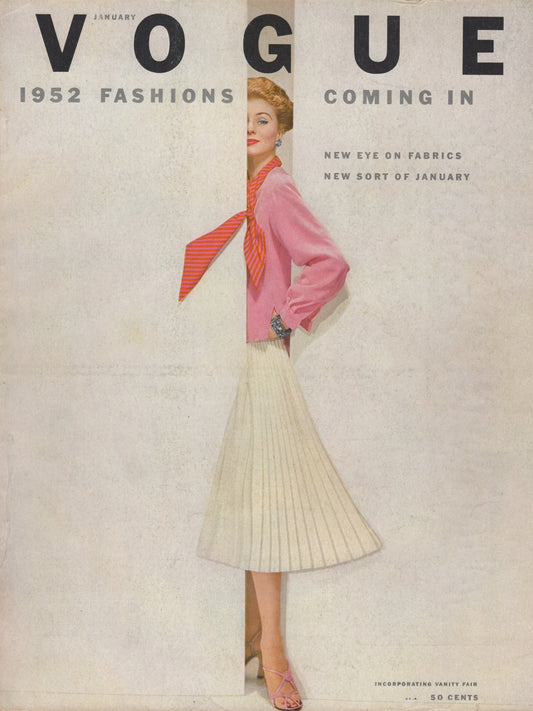 Sold out
Sold outVOGUE US January 1952
Regular price 180 €Regular price -
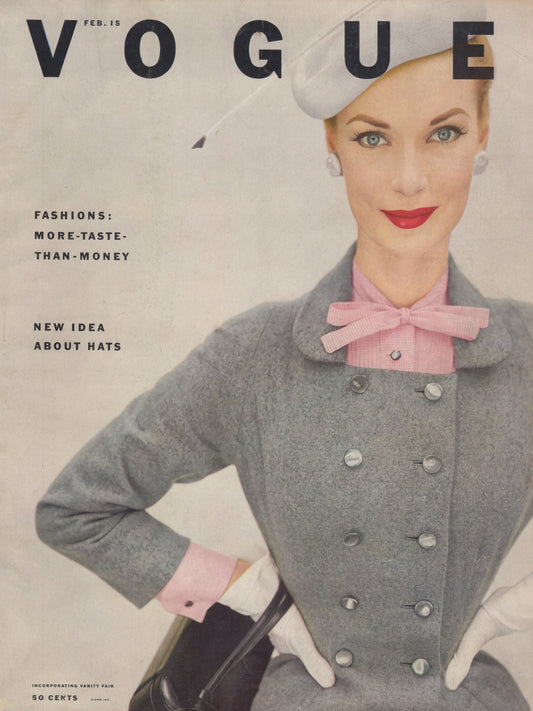 Sold out
Sold outVOGUE US February 15, 1952
Regular price 0 €Regular price -
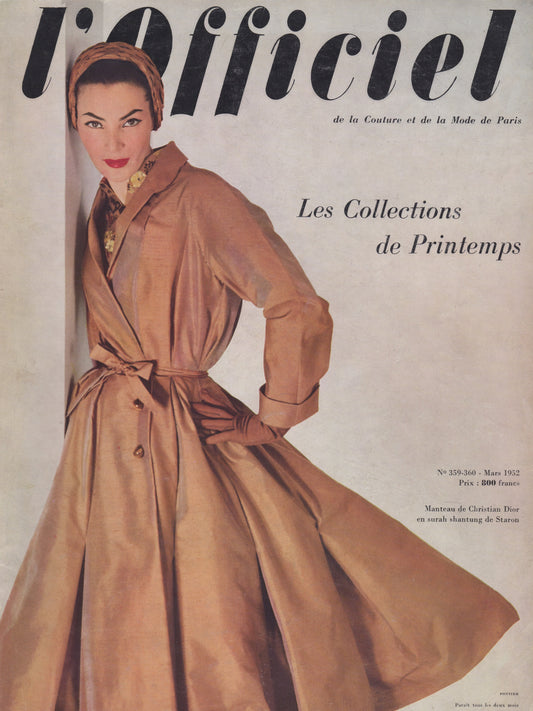 Sold out
Sold outL'OFFICIEL PARIS March 1952
Regular price 0 €Regular price -
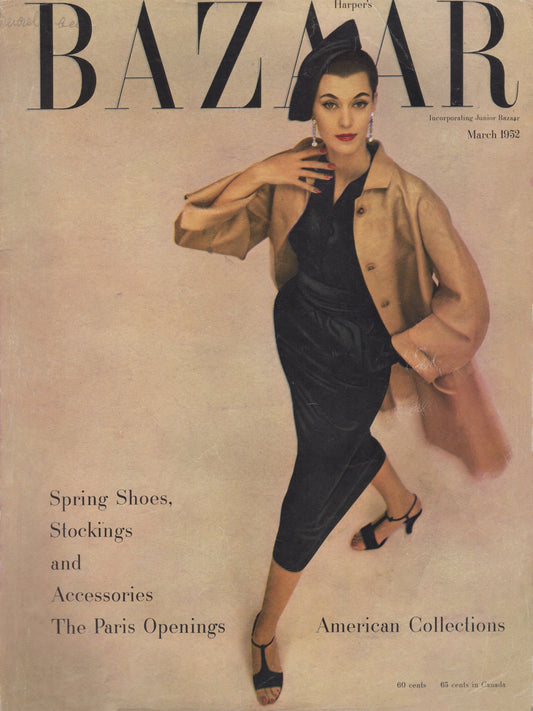 Sold out
Sold outHARPER'S BAZAAR US March 1952
Regular price 0 €Regular price -
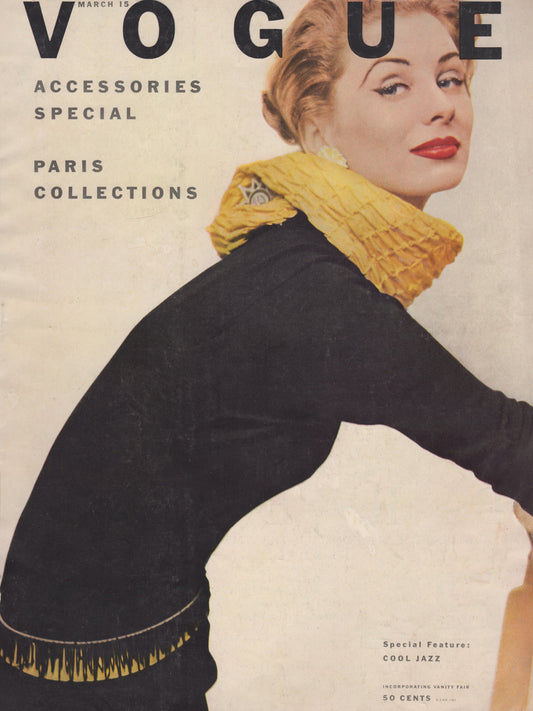 Sold out
Sold outVOGUE US March 15, 1952
Regular price 0 €Regular price -
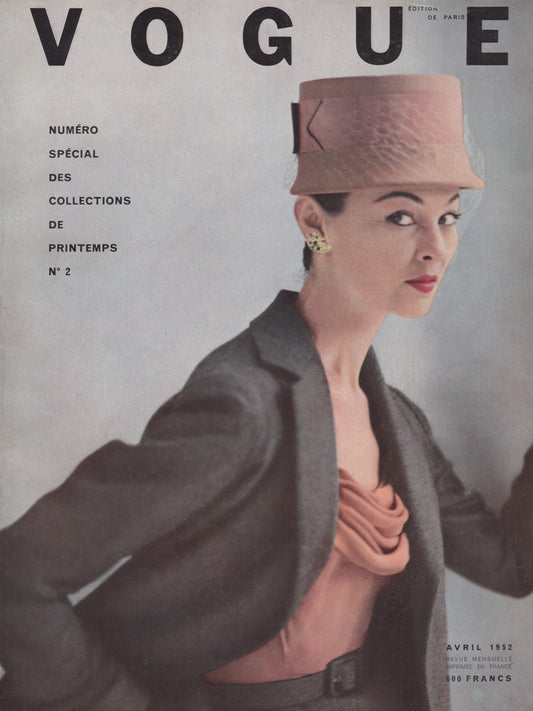 Sold out
Sold outVOGUE Paris April 1952
Regular price 0 €Regular price -
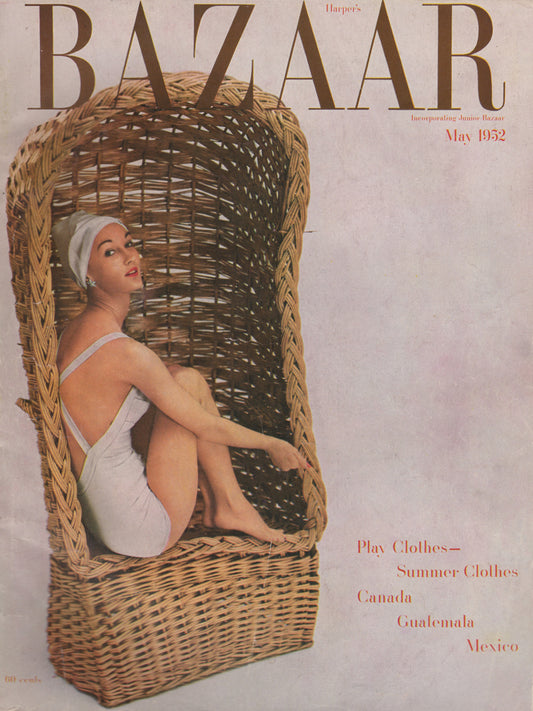 Sold out
Sold outHARPER'S BAZAAR US May 1952
Regular price 0 €Regular price -
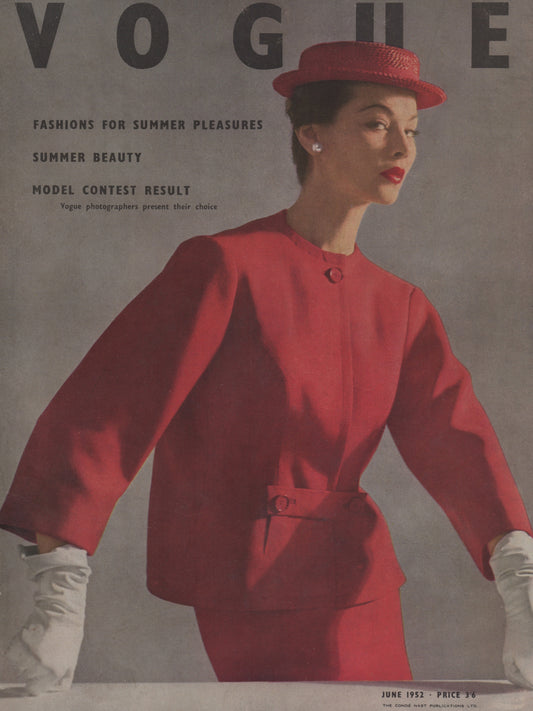 Sold out
Sold outBritish VOGUE UK June 1952
Regular price 270 €Regular price -
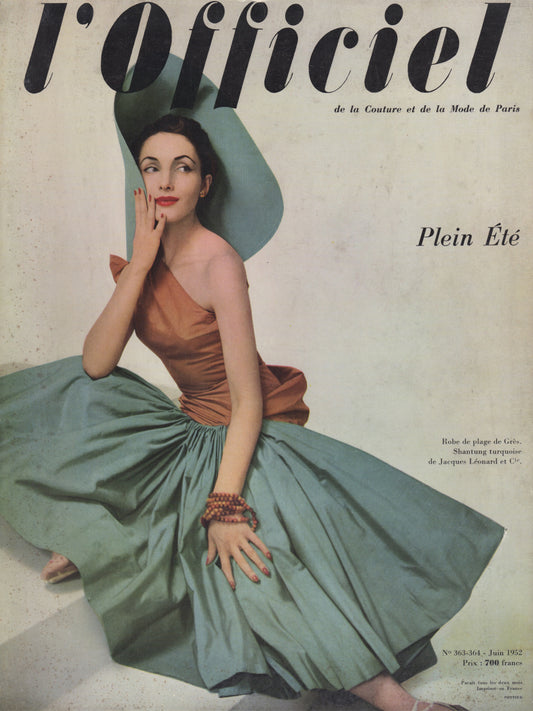 Sold out
Sold outL'OFFICIEL PARIS June 1952
Regular price 0 €Regular price -
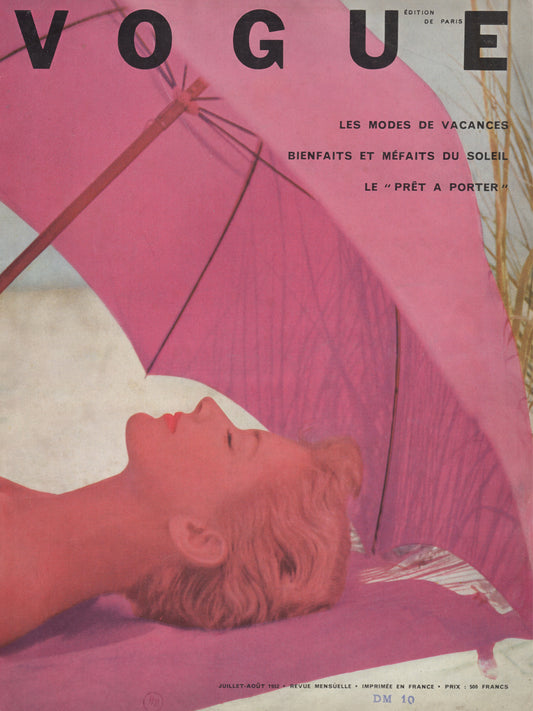 Sold out
Sold outVOGUE Paris July/August 1952
Regular price 0 €Regular price -
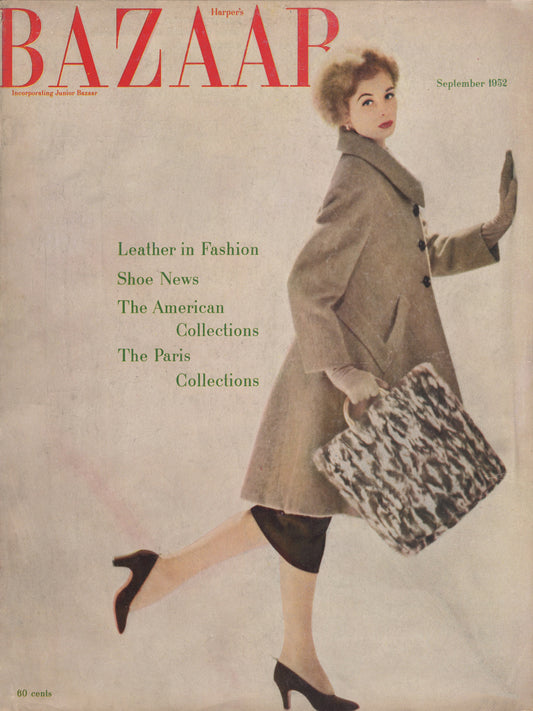 Sold out
Sold outHARPER'S BAZAAR US September 1952
Regular price 0 €Regular price -
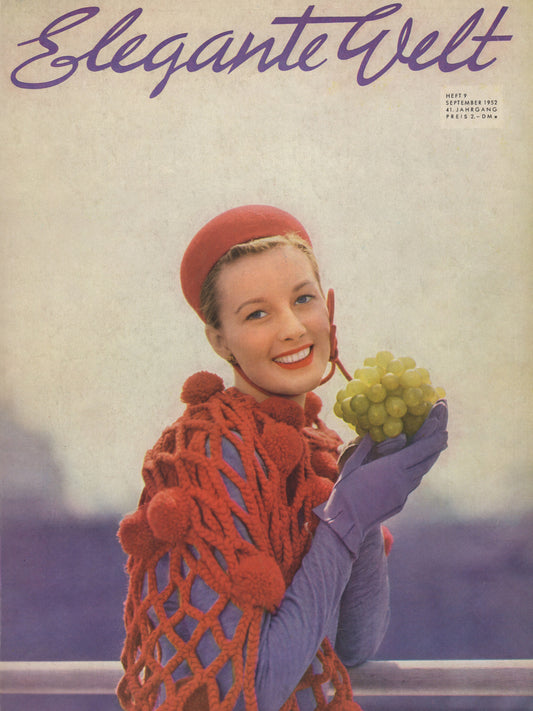 Sold out
Sold outELEGANTE WELT September 1952
Regular price 0 €Regular price -
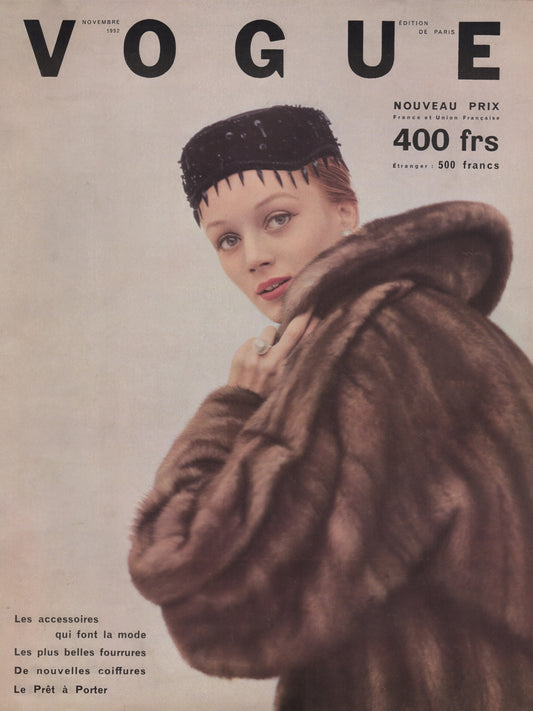 Sold out
Sold outVOGUE Paris November 1952
Regular price 225 €Regular price -
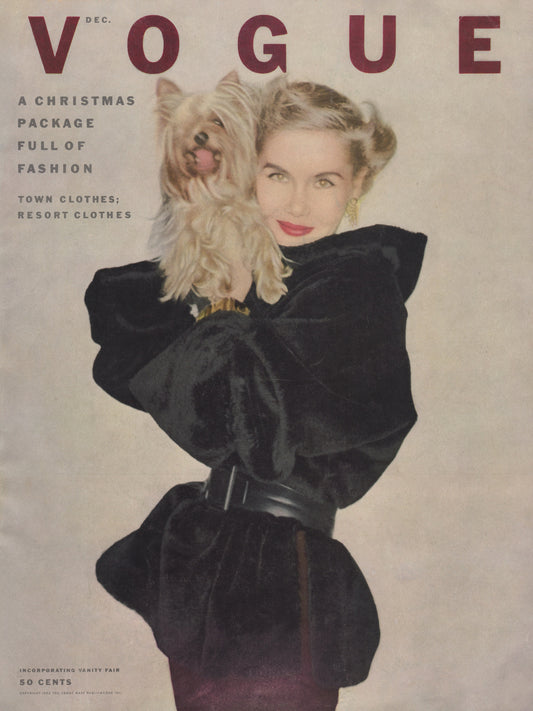 Sold out
Sold outVOGUE US December 1952
Regular price 0 €Regular price -
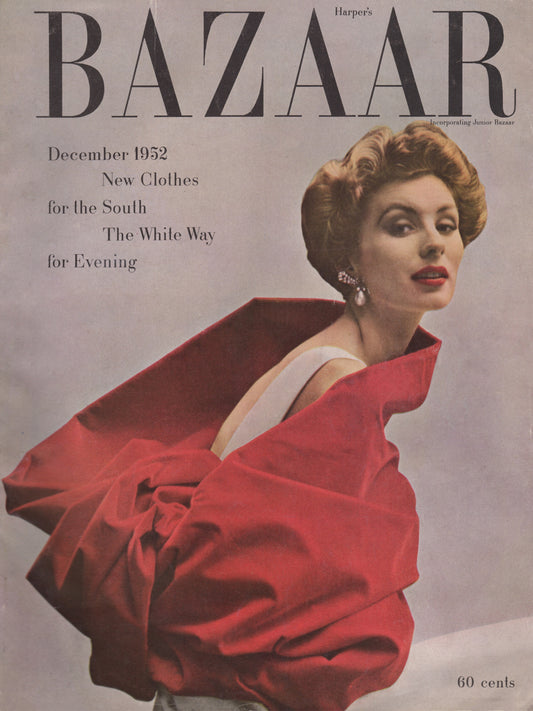 Sold out
Sold outHARPER'S BAZAAR US December 1952
Regular price 0 €Regular price -
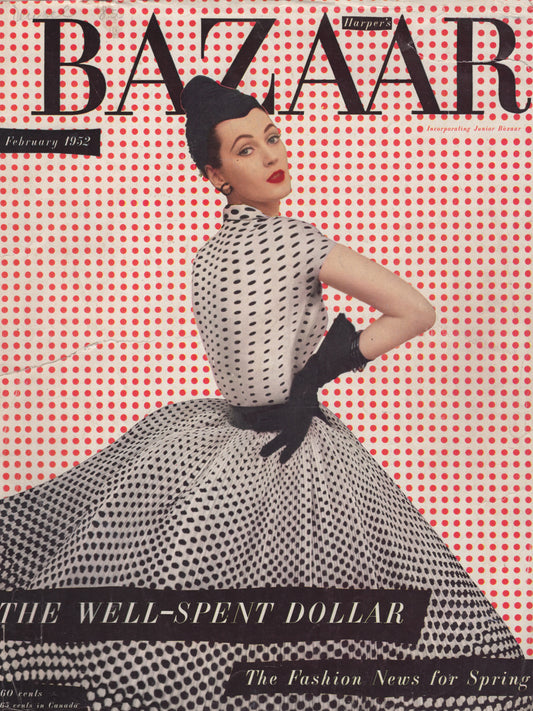 Sold out
Sold outHARPER'S BAZAAR US February 1952
Regular price 390 €Regular price -
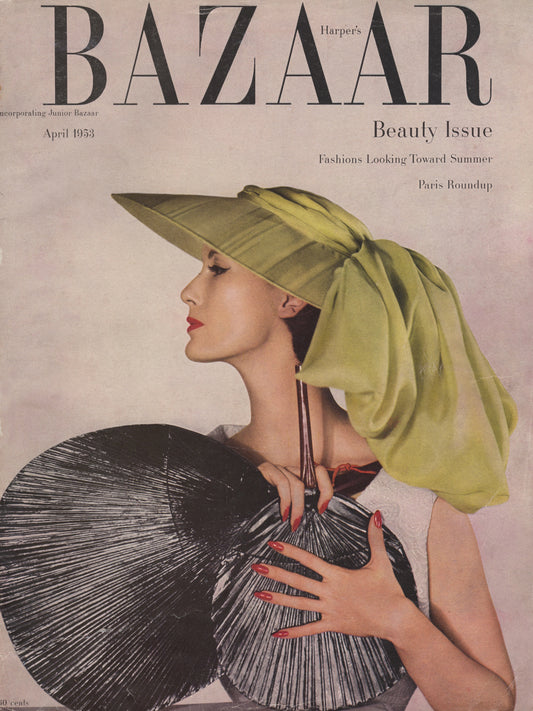 Sold out
Sold outHARPER'S BAZAAR US April 1953
Regular price 270 €Regular price
Dive Into the Fashion Milestones of the 1950s and Discover How Each Year Shaped the Couture World. Click to Explore!
The 1950s Fashion Chronicles: Discover the Year's Major Trends and Designers
